

1. GLOBAL CONTEXT
ENERGY TRANSITION
What is energy transition?
The energy transition is the orderly and programmed change in electricity generation to migrate from conventional energies to Clean Energy with sustainability.
La transición energética es el cambio ordenado y programado de la generación de electricidad para migrar de fuentes convencionales hacia Energías Limpias con sustentabilidad
En México hemos vivido un par de transiciones enérgeticas, desde la generada para iluminación a inicios de 1800, hasta el cambio en el Porfiriato con la llegada de energía eléctrica
Photovoltaic
Hydroelectric
Aeolian Nuclear
Coalelectric
In Mexico we have experienced a couple of energy transitions, from that generated for lighting in the early 1800s, to the change in the Porfiriato with the arrival of electrical energy.
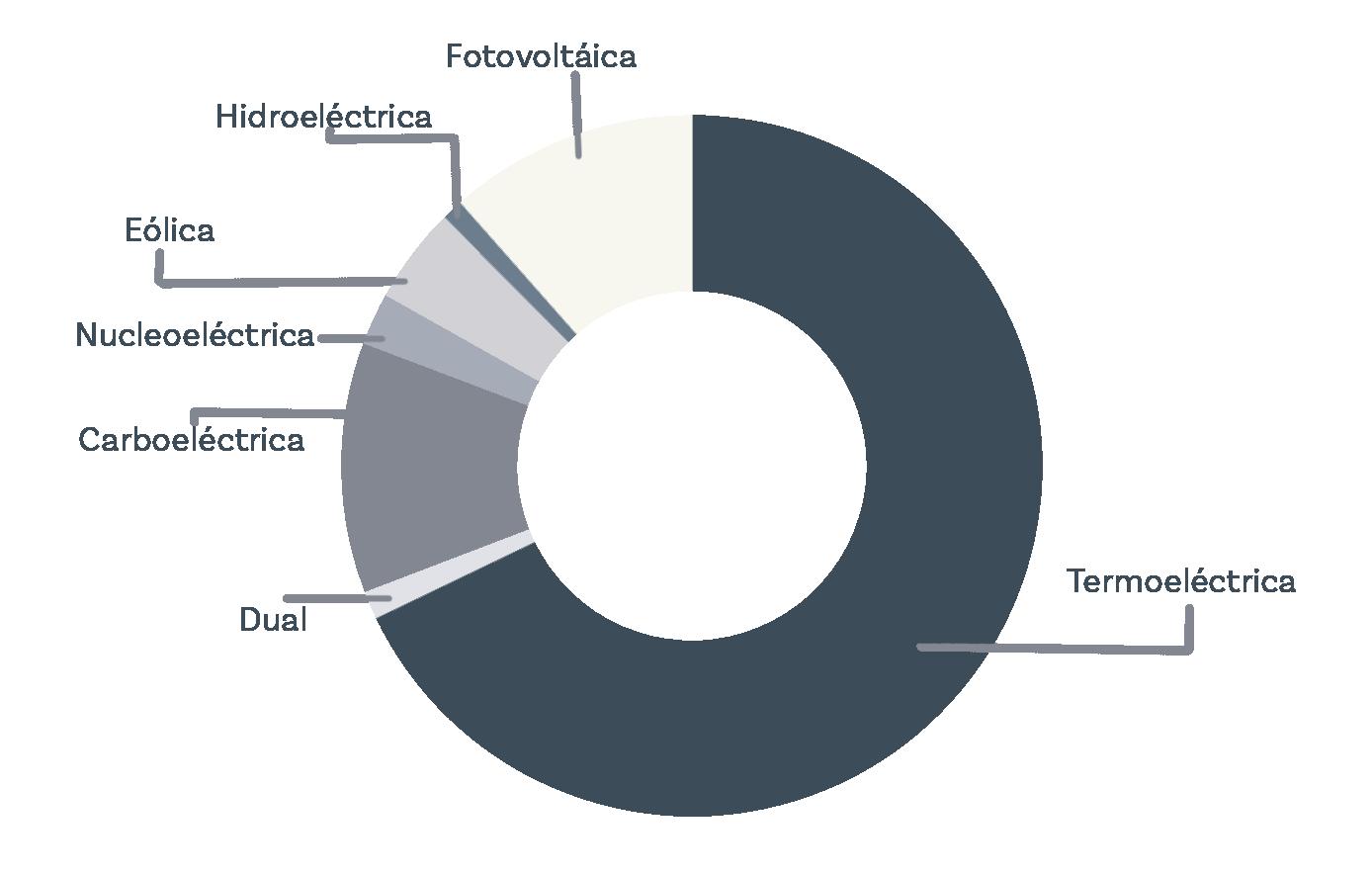
Figura 1: Grafical representation of tipes of energy used in Mexico.
Thermoelectric
Gráfica 2018
Referencias: - TRANSICIÓN ENERGÉTICA. (2023). gob.mx. Recuperado 13 de febrero de 2024, de https://www.gob.mx/cms/uploads/attachment/file/610957/Cap3_-_Transicio_n_ Energe_tica_WEB.pdf Fernández, F. R. (2023, 17 enero). Energías limpias: el reto eléctrico en México. CIEP. https://ciep.mx/energias-limpias-el-reto-electrico-en-mexico/ luminación y electricidad :: Porfiriato-grupo2-2. (s. f.). Porfiriato-grupo2-2. https://porfiriato-grupo2-2.webnode.mx/iluminacion-y-electricidad2/
How was electricity experienced in Mexico?
Light was a limitation for the daily life of Mexicans. When electricity arrived, there was a difference in its privilege, although the working class lived with jobs generated by it, they did not enjoy the same reach as the “High society” and “Bourgeoisie”.
La iluminación era una limitante para la vida cotidiana de los Mexicanos.
Al llegar la electricidad, se vivió una diferencia de privilegio de esta, aunque la clase trabajadora vivía con empleos generados por ella, no gozaban del mismo alcance tal como la “Alta sociedad” y “Burguesía”


México es un país que cuenta con una geografía y condiciones naturales óptimas para la generación de energias alternativas. Además se ha diversificado aprovechando su potencial para la colocación de estas. Se estima que en un futuro, generar energía limpia no sea únicamente bueno para el medio ambiente, sino, que sea accesible para todas las clases sociales y la inversión de uso sea adecuada
Mexico is a country that has optimal geography and natural conditions for the generation of alternative energies. In addition, it has diversified, taking advantage of its potential for the placement of these.
It is estimated that in the future, generating clean energy will not only be good for the environment, but will also be accessible to all social classes and the investment in use will be appropriate.
Referencias: - Universal, R. E. (2018, 12 diciembre). Cuando llegó la luz eléctrica a la ciudad de México. El Universal. https://www.eluniversal.com.mx/mochilazo-en-el-tiempo/ cuando-llego-la-luz-electrica-la-ciudad-de-mexico/
DECARBONIZATION
Descarbonización
What is decarbonization?
Decarbonization consists of a process of gradual reduction of emissions that will affect multiple aspects of our way of life. These emissions, mainly carbon dioxide, are produced by human activity.
¿Qué es la descarbonización?
La descarbonización consiste en un proceso de reducción gradual de emisiones que afectará a múltiples aspectos de nuestra forma de vida. Estas emisiones, principalmente dióxido de carbono, son producidas por la actividad humana.

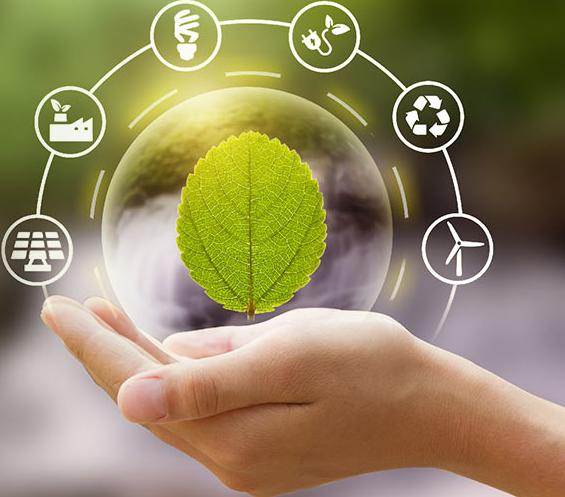
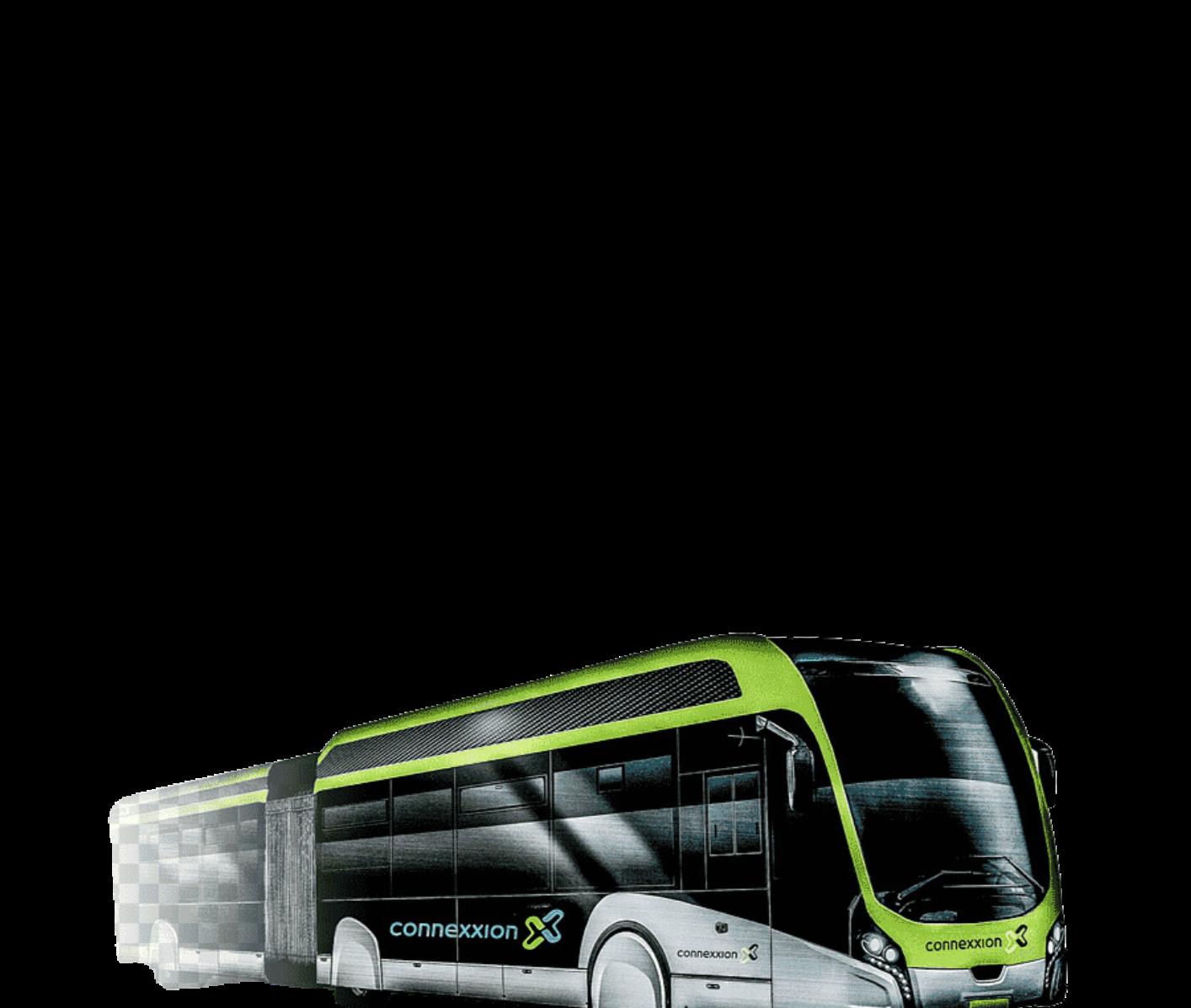



STRATEGIES FOR LARGE INDUSTRIES AND GOVERNMENT.
1. Invest in large-scale renewable energy infrastructure.
2. Develop and implement the use of efficient, lowemission public and individual transportation methods such as electric cars.
3. Development of waste management systems that promote reduction, recycling and reuse.
4. Implementation of green spaces, as well as industrial facilities following principles of sustainability and efficient urban planning.
5. Invest in research to develop new technologies to reduce industrial emissions.
6. Establish policies that promote sustainable practices and ensure compliance with them.
1. Invertir en infraestructura que genere energía renovable a gran escala
2. Desarrollar e implementar el uso de métodos de transporte público e individual eficiente y de bajas emisiones como coches eléctricos.
3. Desarrollo de sistemas de gestión de residuos que promuevan la reducción, el reciclaje y la reutilización.
4. Implementación de espacios verdes, así como instalaciones industriales siguiendo principios de sostenibilidad y planificación urbana eficiente.
5. Invertir en la investigación para el desarrollo de nuevas tecnologías para reducir las emisiones industriales.
6. Establecer políticas que promuevan prácticas sostenibles y asegurarse del cumplimiento de estas.


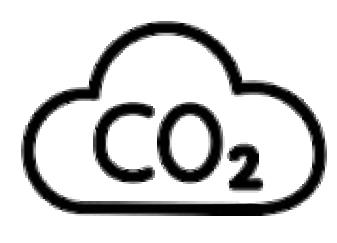






Cities occupy 2% of the territory and represent 76% of energy demand and its associated emissions, which come mainly from transportation and buildings.


Cities produce 60% of CO2 emissions, 60% of resource use and 50% of global waste.




STRATEGIES THAT WE CAN CARRY OUT INDIVIDUALLY.
1. Use public transportation, cycling, or walking instead of private vehicles with combustion engines.
2. Adopt energy efficient practices at home, such as the use of LED lighting, smart thermostats, and efficient appliances.
3. Opt for recycling which helps to reduce the use of single-use products.
4. If you have the possibility, opt for personal electric vehicles.
5. Implement green technologies at home, such as solar panels, energy storage systems and smart devices for efficient management.
6. Buy products and services that are sustainable.
1. Utilizar el transporte público, la bicicleta, o caminar en lugar de vehículos privados con motor de combustión.
2. Adoptar prácticas de eficiencia energética en casa, como el uso de iluminación LED.
3. Optar por el reciclaje.
4. Optar por vehículos eléctricos personales.
5. Implementar tecnologías verdes en el hogar, como paneles solares y sistemas de almacenamiento de energía.
6. Comprar productos y servicios que sean sostenibles.
URBAN TRANSITION
Transición urbana
What
does
transitioning
away from
fossil
fuels mean for the future of capitalism?
¿Qué significa para el futuro del capitalismo abandonar los combustibles fósiles?
The fossil fuel industry has been a major driver of the global economy for decades. Transitioning away from fossil fuels implies a shift towards cleaner and more sustainable energy sources, such as renewable energy. This transition can lead to the growth of new industries, job creation in renewable energy sectors, and changes in economic structures.
La industria de los combustibles fósiles ha sido un importante motor de la economía mundial durante décadas. La transición para abandonar los combustibles fósiles implica un cambio hacia fuentes de energía más limpias y sostenibles, como las energías renovables. Esta transición puede conducir al crecimiento de nuevas industrias, la creación de empleo en sectores de energía renovable y cambios en las estructuras económicas.


“Klein argues that humans don’t cause climate collapse, and nor does carbon. The problem is a particular arrangement of these elements – in other words, capitalism, the whole point of which is to find resources and exploit them. It’s a habit of mind, if you like, a form of behavior. As such, it can be changed. Except that most of the time we cannot see this, because we are “locked in, politically, physically and culturally” to the world that capital has made. “We lack the collective spaces in which to confront the raw terror of ecocide,” is how Klein encapsulates the problem. Lucky for everybody then that opening up such spaces is exactly what Klein does best.” (Turner, 2014).
“Klein sostiene que los humanos no causan el colapso climático, ni tampoco el carbono. El problema es una disposición particular de estos elementos; en otras palabras, el capitalismo, cuyo objetivo es encontrar recursos y explotarlos. Es un hábito mental, si se quiere, una forma de comportamiento. Como tal, se puede cambiar. Excepto que la mayor parte del tiempo no podemos ver esto, porque estamos “atrapados política, física y culturalmente” al mundo que ha creado el capital. “Carecemos de espacios colectivos para enfrentar el crudo terror del ecocidio”, así resume Klein el problema. Por suerte para todos, abrir esos espacios es exactamente lo que Klein hace mejor”. (Turner, 2014).
Successful example
Ejemplo exitoso
The Ukraine war accelerated Germany’s move to renewable energy, reducing reliance on Russian gas. Short-term measures included extending coal use, but it prompted ambitious policies for longterm sustainability goals. The conflict marked a significant shift towards cleaner energy sources.
La guerra de Ucrania aceleró el paso de Alemania hacia la energía renovable, reduciendo la dependencia del gas ruso. Las medidas a corto plazo incluyeron ampliar el uso del carbón, pero impulsaron políticas ambiciosas para objetivos de sostenibilidad a largo plazo. El conflicto marcó un cambio significativo hacia fuentes de energía más limpias.

Transición urbana
Cities play a crucial role in driving the energy transition, as they are significant consumers of energy and sources of greenhouse gas emissions. Setting ambitious renewable goals to invest in sustainable infrastructure towards more energy-efficient buildings and transportation systems, fueled by renewable energy is what cities need to do.
Cities that are able to adapt and carry out the necessary transformations efficiently will end up being more competitive (that is, more capable of generating sustainable economic activity and social well-being).
Las ciudades desempeñan un papel crucial a la hora de impulsar la transición energética, ya que son importantes consumidoras de energía y fuentes de emisiones de gases de efecto invernadero. Lo que las ciudades deben hacer es establecer objetivos renovables ambiciosos para invertir en infraestructura sostenible hacia edificios y sistemas de transporte más eficientes energéticamente, impulsados por energía renovable.
Las ciudades que sean capaces de adaptarse y llevar a cabo las transformaciones necesarias de manera eficiente terminarán siendo más competitivas (es decir, más capaces de generar actividad económica sostenible y bienestar social).
Cities now run largely on fossil fuels. Consuming about 78% of the world’s energy.
Cities now run largely on fossil fuels. Consuming about 78% of the world’s energy.
Urban transport alone accounts for the equivalent of 4 billion tonnes of CO2 emissions.
El transporte público representa el equivalente de 4 mil millones de emisiones de CO2.
More than 50% of the world’s population lives in cities and this percentage is expected to grow around 70% by 2050.
Más del 50% de la población mundial vive en ciudades y se estima que este porcentaje crezca alrededor del 70% en 2050.
Cities represent 3% of the earth, however, their energy consumption is 60 to 80% of energy consumption. A pesar de que las ciudades representan el 3% de la tierra, su consumo de energía llega a ser entre el 60% y 80%.

Los centros urbanos generan alrededor del 80% del PIB mundial. Urban centers generate around 80% of the world’s GDP.
How can urban infrastructure address energy challenges?
¿Cómo puede la infraestructura urbana abordar los desafíos energéticos?


Urban infrastructure is a vital part for cities to exist. It is needed that newer developments have stricter guidelines for a more sustainable future. Incorporating renewable energy sources is vital for achieving energy-sufficient urban construction. Smart communication systems enable the seamless integration of renewable energy sources, such as solar panels and wind turbines, into the urban infrastructure. By banning the use of fossil fuels as a primary source of energy production, the toxic fumes being released into the environment start disappearing and the greenhouse effect gets better overtime. A way to incentivize or push countries towards a greener future is by offering tax breaks, health and wellness reimbursements, monetary bonuses, etc.
La infraestructura urbana es una parte vital para que existan las ciudades. Es necesario que los nuevos desarrollos tengan directrices más estrictas para un futuro más sostenible. La incorporación de fuentes de energía renovables es vital para lograr una construcción urbana energéticamente suficiente. Los sistemas de comunicación inteligentes permiten la integración perfecta de fuentes de energía renovables, como paneles solares y turbinas eólicas, en la infraestructura urbana. Al prohibir el uso de combustibles fósiles como fuente primaria de producción de energía, los humos tóxicos que se liberan al medio ambiente comienzan a desaparecer y el efecto invernadero mejora con el tiempo. Una forma de incentivar o empujar a los países hacia un futuro más verde es ofreciendo exenciones fiscales, reembolsos de salud y bienestar, bonificaciones monetarias, etc.
Referencias:
Turner, J. (2014). This Changes Everything: Capitalism vs the Climate by Naomi Klein. Recuperado de: https://www.theguardian.com/books/2014/sep/19/ this-changes-everything-capitalism-vs-climate-naomi-klein-review Fernandez, J. (2021). ¿Por qué las ciudades son clave para el éxito de la transición energética mundial? Recuperado de: https://www.orkestra.deusto.es/es/actualidad/noticias-eventos/beyondcompetitiveness/2271-por-que-las-ciudades-son-clave-para-el-exito-de-la-transicion-energetica-mundial Simpson, B. (2023). War in Ukraine speeding up Germany’s transition to renewables. Recuperado de: https://theworld.org/stories/2023-07-10/war-ukraine-speeding-germanys-transition-renewables
SUSTAINABLE DEVELOPMENT GOALS SDG
SDG (Sustainable Development Goals) are17 goals adopted by the United Nations in search for a planet in which everyone lives in prosperity and peace, both us as people, and with our environment in hope for a more sustainable tomorrow for the next generations.
Los ODS (Objetivos de Desarrollo Sostenible) son 17 objetivos adoptados por las Naciones Unidas en busca de un planeta en el que todos vivamos en prosperidad y paz, tanto nosotros como personas como con nuestro medio ambiente, con la esperanza de un mañana más sostenible para las próximas generaciones.
In regards to energy transition, goal #7 affordable and clean energy aims directly at this. Working towards guaranteeing affordable, reliable, sustainable and modern energy for all. Having a big focus on duplicating energy efficiency and international cooperation for the research and investment of new technologies. In order to achieve this goal, each country has to prove that all its population has access to electricity, clean fuels and technology for cooking, as well as proving that all its energy consumption is renewable, and the production of electricity divided by the CO2 emissions from the combustion of fuel is zero.
Nevertheless, with the changes that the energy transition can produce, other SDG can potentially be affected; According to UNDP in 2022, the achievements on this goal contributed to the following:
SDG#13 on Climate Action, with 400 million tons of CO2 emissions being averted
SDG#6 on Clean water and Sanitation, with an additional 300,000 people accessing clean, safe drinking water
SDG#4 on Quality Education, with 70,700 new students attending schools due to new transportation, illuminated routes or powering schools through solar energy.
En cuanto a la transición energética, el objetivo número #7: Energía asequible y no contaminante, apunta directamente a esto. Trabajando para garantizar una energía fiable, sostenible y moderna para todos. Teniendo un enfoque en duplicar la eficiencia energética y la cooperación internacional para la investigación e inversión de nuevas tecnologías. Para lograr este objetivo, cada país tiene que demostrar que toda su población tiene acceso a electricidad, combustible limpio y tecnología para cocinar, demostrar que todo su consumo energético es renovable y la producción de electricidad dividida por las emisiones de CO2 de la combustión es cero. Sin embargo, con los cambios que puede producir la transición energética, otros ODS pueden verse potencialmente afectados; Según el UNDP en 2022, los logros en esta meta contribuyeron a lo siguiente:
• ODS#13: Acción por el Clima, con 400 millones de toneladas de emisiones de CO2 evitadas ODS 6: Agua limpia y saneamiento, con 300.000 personas más accediendo a agua potable limpia y segura
ODS#4: Educación de Calidad, con 70.700 nuevos estudiantes asistiendo a escuelas debido a nuevos transportes, rutas iluminadas o impulsando escuelas a través de energía solar.

Figure 12: Direct and Indirect influence of SDG#7 with all the others.
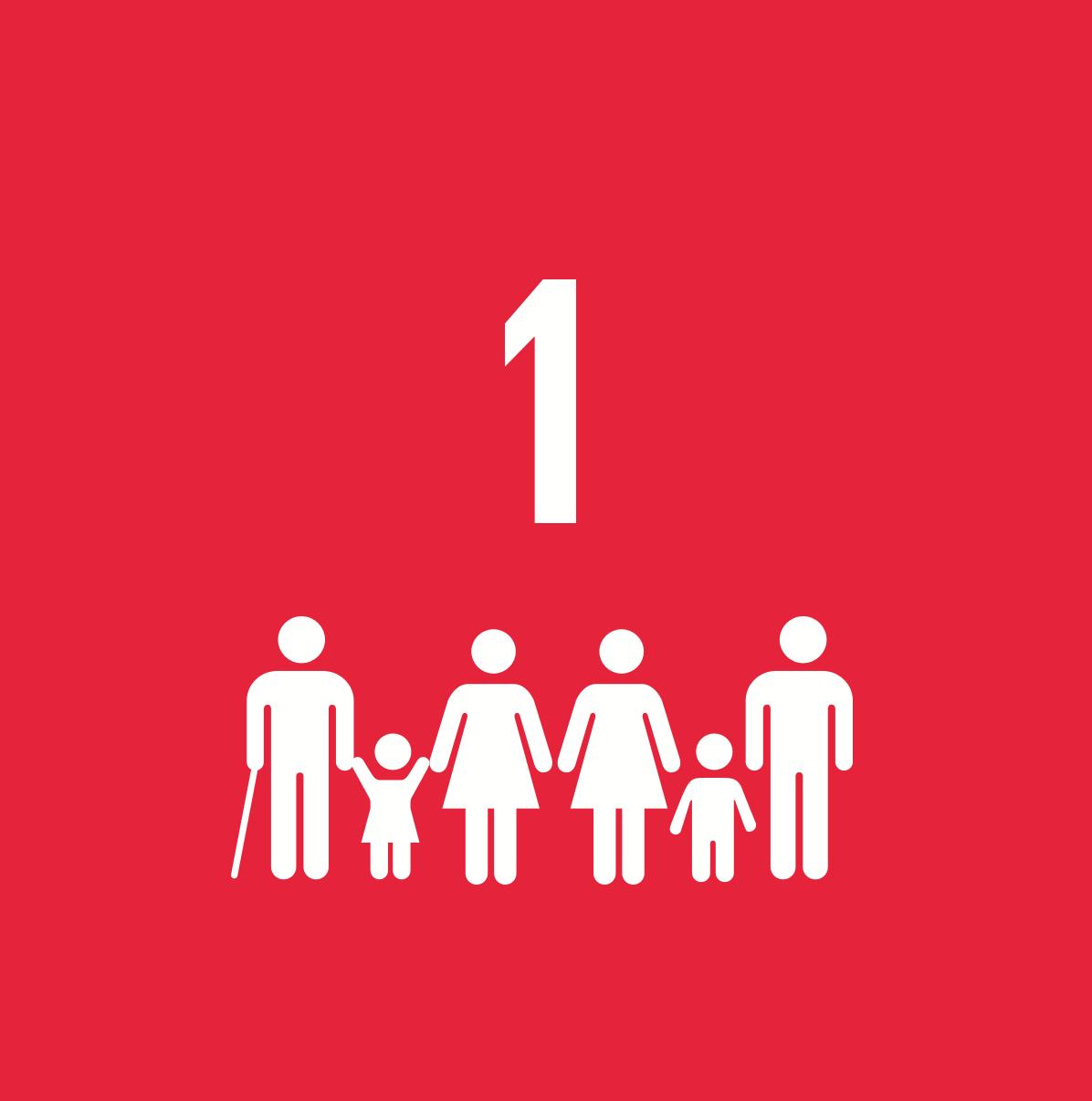
#1 No Poverty
raising living standards, preventing cuts in energy supplies and access to electricity

#5 Gender Equality
women spend 18 hours collecting fuel for cooking

#10 Reduced Inequalities
leaving no one behind by giving them the same possibilities

#14 Life Below Water
reducing acidification and pollution

#2 No Hunger
helping with food storage, preparation, distribution and production

#3 Good Health & Well Being

key for availability and reliability of health services

#6 Clean Water & Sanitation

#8 Decent Work & Economy Growth

more access to energy is highly correlated to an economy growth

#11 Sustainable Cities & Communities make settlements safe and sustainable

#12 Responsible Consumption & Production

encouraging more sustainable consumption

#4 Quality Education
#9 Industry Innovation & Infrastructure
promoting sustainable industrialization
#13 Climate Action

#15 Life on Land #16 Peace, Justice & Strong Institutions
trading the wood forests needed for fuel, for sustainable options
allowing for climate justice

#17 Partnerships for the Goals
enabling the mobilization and sharing of knowledge and resources for everyone
References: TheGlobalGoals. (n.d) Goal:7 Affordable and clean energy. GlobalGoals. Retrieved from: https://www.globalgoals.org/goals/7-affordable-and-cleanenergy/#things-to-do UN Energy Compacts. (2022) Annual Progress Report 2022. UN. Retrieved from: https://www.un.org/sites/un2.un.org/files/energy_compacts_annual_progress_report_2022_-_final_version_v2.pdf
ENERGETIC DISTRICTS
Distritos energéticos
Historic context
“Growth at all costs” is a mentality that has led us to the climate crisis we currently face. Urban development remains one of the largest decarbonisation challenges, recognized since 1978 in the Brundtland Report. Nowadays, aided by Information and Communication Technology (ICT), we are able to analyze, predict and manage an entire community’s energy cycle; thus becoming a smart energetic district.
“Crecer a toda costa” es una mentalidad que nos llevó a la crisis climática actual. El desarrollo urbano persiste como uno de los retos de descarbonización más grandes, siendo reconocido desde 1978 en el Informe de Brundtland. Actualmente, apoyados por Tecnologías de Comunicación e Información (TCI), podemos analizar, predecir y administrar el ciclo energético de una comunidad entera; convirtiéndola en un distrito energético inteligente
Role in cities
These smart communities seek sustainability, focusing in three dimensions: society, environment and economy. Here, technology is crucial, enabling innovation through efficiency. Today, ambitious projects such as GrowSmarter have benefited pilot cities like Barcelona, where energetic districts have been consolidated through local production and management of renewable energy, while linking buildings to new heating and cooling networks.
Estas comunidades inteligentes buscan la sostenibilidad, enfocándose en tres dimensiones: sociedad, medio ambiente y economía. Aquí, la tecnología es crucial, permitiendo innovación mediante eficiencia. Hoy, proyectos ambiciosos como GrowSmarter han beneficiado ciudades piloto como Barcelona, donde se han consolidado distritos energéticos a través de la producción y gestión local de energía renovable, conectando edificios a nuevas redes de calefacción y refrigeración.


NETWORKS
Centralized distribution
Flexible services
Smart networks
BUILDINGS
Thermic services
Citizen services Energy efficiency
ENERGETIC DIST RICT PRINCIPLES

WATER& R ESOURCES
Smart water management
Circular economy
MOBILITY
Sustainable mobility
Hydrogen as energy
GOALS WORLDWIDE
Metas mundiales
Employing number 7 of the Sustainable Development Goal as the framework to which most nations have aligned, we will focus on analyzing the progress and goals that both countries and cities from the global north and south have strided towards. These cities represent a diversity of energetic profiles with different geopolitical and economic backgrounds, achieving a varied analysis.
We found a lack of transparency at both national and local levels for some regions where their energy mix was unavailable. This absence of information hinders the ability to self-evaluate progress, therefore we suggest the promotion of open data from public and private entities.
Tomando el Objetivo número 7 de Desarrollo Sostenible como el marco regulatorio al que se alinearon los países, nos centraremos en analizar los avances alcanzados y metas propuestas por el norte y sur global. Las ciudades analizadas representan una diversidad de perfiles energéticos con contextos geopolíticos y económicos distintos, logrando así un análisis variado.
Encontramos una ausencia de transparencia a nivel tanto nacional como local para algunas regiones en donde su distribución energética por fuentes no estaba disponible. Esta falta de información atienta contra la habilidad para autoevaluar progreso, por lo que sugerimos la promoción de datos abiertos para entidades públicas y privadas.
zero by 2050, invest in solar and wind4
GHG emissions and reduce carbon footprint by 40% by 203010
1. Country energy mix: Energy Institute (2023) Statistical Review of World Energy 2023. https://www.energyinst.org/__data/assets/pdf_file/0004/1055542/EI_Stat_ Review_PDF_single_3.pdf
2. SDG7 progress: Drumm et al. (2023). Implementing the SDG Stimulus. Sustainable Development Report 2023. Paris: SDSN, Dublin: Dublin University Press. DOI: 10.25546/102924
3. Compare Electricity (2023) Sources: Cleveland, OH 44147. https://compareelectricity.com/energy-sources/OH/Cleveland/44147
4. City of Cleveland, Mayor’s Office of Sustainability (2021) Cleveland’s Clean and Equitable Energy Future. https://d3n8a8pro7vhmx.cloudfront.net/sustainablecleveland/pages/34927/attachments/original/1617974714/Greenlink_ClevelandReport_040921_final_single_pages.pdf?1617974714
5. CleanPowerSF (2024) Energy Sources. https://www.cleanpowersf.org/energysources
6. C40 Cities (2016) Cities100: San Francisco - Equitable Retrofits Lower Energy Bills https://www.c40.org/en/case-studies/cities100-san-francisco-equitable-retrofits-lower-energy-bills/
7. Green City TImes (2024) Reykjavik, Iceland. https://www.greencitytimes.com/reykjavik/
8. Liberal de Castilla (2021) La provincia de Cuenca genera el 2,4% de la energía renovable de España. https://www.liberaldecastilla.com/la-provincia-de-cuencagenera-el-24-de-la-energia-renovable-de-espana
9. Ayuntamiento de Cuenca (2024) Estrategia de desarrollo urbano sostenible de Cuenca https://feder.cuenca.es/estrategia-de-desarrollo-urbano-sostenible-de-cuenca
10. Choose Paris Region (2024) Renewable energy https://www.chooseparisregion.org/industries/Renewable-energy
Cuenca generates 2.4% of clean energy nationally, and accounting for 6% of Madrid’s annual supply
Iceland aims to achieve carbon neutrality before 2040; U.S will follow 10 years later
0Cuenca genera el 2,4% de la energía limpia de España, y 6% del consumo eléctrico anual de Madrid
Islandia planea la neutralidad de carbono antes de 2040; EE.UU lo logrará 10 años después
NORTH / SOUTH
Costa Rica has the largest share of renewable energy mix with 36.4% and South Africa falls short 4%
Costa Rica has the most hydro (73%) and wind power (12.4%). Indonesia leads geothermal (4%).
Jakarta follows Santiago’s example of achieving 100% clean public transport.
Costa Rica genera más energía renovable con 36,4% y Sudáfrica solo produce 4%
Costa Rica tiene más energía hidroeléctrica (73%) y eólica (12,4%); Indonesia geotérmica (4%).
Yakarta sigue el ejemplo de Santiago de lograr un transporte público 100% limpio.
11. La Voz Querétaro (2024) ¿Cómo avanza Querétaro en materia de energías limpias? https://lavozdequeretaro.com/futuro-sustentable/como-avanza-queretaro-en-materia-de-energias-limpias/
12. Cluster Industrial (2023) El Sistema de Economía Circular de Querétaro redujo 681 mil toneladas de CO2 en 2023 https://www.clusterindustrial.com.mx/noticia/7137/el-sistema-de-economia-circular-de-queretaro-redujo-681-mil-toneladas-de-co2-en-2023
13. Gobierno de la Ciudad de México (2022) Diagnóstico de Transición Energética de la CIudad de México https://ciudadsolar.cdmx.gob.mx/storage/app/media/ Documentos%20en%20%20colaboraciones%20o%20importantes/diagnostico-de-transicion-energetica-cdmx.pdf:
14. Revista SUMMA (2023) San José, Costa Rica se perfila para lograr el 100% energía renovable para 2030 https://revistasumma.com/san-jose-costa-rica-se-perfila-para-lograr-el-100-energia-renovable-para-2030/
15. Teng, R. (2023) How Santiago became one of the first cities to electrify public transport at scale. GovInsider. https://govinsider.asia/intl-en/article/how-santiago-became-one-of-the-first-cities-to-electrify-public-transport-at-scale
16. REN21 (2021) Cape Town https://www.ren21.net/cities-2021/cities/capetown/capetown/ 17. Hazarika, G. (2022) Delhi’s Draft Solar Policy Targets 6,000 MW Capacity by 2025. MERCOM https://www.mercomindia.com/delhis-draft-solar-policy-targets-mw-capacity-2025
18. Sanderson, C. (2024) China starts work on massive green project to power Beijing. Recharge https://www.rechargenews.com/energy-transition/china-startswork-on-massive-green-project-to-power-beijing/2-1-1580195
19. REN21 (2021) Trends in Indonesia Facts from the Renewables in Cities 2021 Global Status Report. https://www.ren21.net/wp-content/uploads/2019/05/REN21_ Cities2021_Fact-Sheet_Indonesia.pdf
GOALS WORLDWIDE
How is progress achieved worldwide?
Employing number 7 of the Sustainable Development Goal as the regulatory framework to which most nations have aligned, we will focus on analyzing the progress and goals that both countries and cities from the global north and south have strided towards.
This cities represent a diversity of energetic profiles with different geopolitical and economic backgrounds, with this we achieve a vast analysis from diferent perspectives.
Tomando el Objetivo número 7 de Desarrollo Sostenible como el marco regulatorio al que se alinearon la mayoría de países, nos centraremos en analizar los avances y metas que los países y ciudades del norte y sur global han realizado para alcanzarlo.
Las ciudades analizadas representan una diversidad de perfiles energéticos con contextos geopolíticos y económicos distintos, logrando así un análisis variado.
*We found out that national and local entities should share energy mix data publicly to gain transparency and for means of future self-evaluation during their energy transition efforts.
*Después de nuestra investigación, descubrimos que las entidades nacionales y locales deberían compartir públicamente los datos de la combinación energética para ganar transparencia, como medio de autoevaluación futura durante sus esfuerzos de transición energética.
Net zero by 2050, invest in solar and wind4
Reduce 300,000 CO2 tons by 20306
All electricity is already sourced renewably7
Net zero by 20407
N/A
New 2MW solar plant8 Interest for EV overhaul in public transport8
million euros aimed towards local policies10 *% of Spain’s hydro
N/A
Halve GHG emissions and reduce carbon footprint by 40% by 203011
Main renewable energy source (%) [1]
Figure 13: International goals.
1. Country energy mix: Energy Institute (2023) Statistical Review of World Energy 2023. https://www.energyinst.org/__data/assets/pdf_file/0004/1055542/EI_Stat_ Review_PDF_single_3.pdf
2. SDG7 progress: Drumm et al. (2023). Implementing the SDG Stimulus. Sustainable Development Report 2023. Paris: SDSN, Dublin: Dublin University Press. DOI: 10.25546/102924
3. Compare Electricity (2023) Sources: Cleveland, OH 44147. https://compareelectricity.com/energy-sources/OH/Cleveland/44147
4. City of Cleveland, Mayor’s Office of Sustainability (2021) Cleveland’s Clean and Equitable Energy Future. https://d3n8a8pro7vhmx.cloudfront.net/sustainablecleveland/pages/34927/attachments/original/1617974714/Greenlink_ClevelandReport_040921_final_single_pages.pdf?1617974714
5. CleanPowerSF (2024) Energy Sources. https://www.cleanpowersf.org/energysources
6. C40 Cities (2016) Cities100: San Francisco - Equitable Retrofits Lower Energy Bills https://www.c40.org/en/case-studies/cities100-san-francisco-equitable-retrofits-lower-energy-bills/
7. Green City TImes (2024) Reykjavik, Iceland. https://www.greencitytimes.com/reykjavik/
8. AdEPORTO (2019) Lisbon And Porto Assume Goals For Energy Decentralization https://www.adeporto.eu/en/news-1/lisW
Cuenca generates 2.4% of clean energy nationally, accounting for 6% of Madrid’s annual supply. Cuenca genera el 2,4% de la energía limpia de España, 6% del consumo eléctrico anual de Madrid.
Iceland aims to achieve carbon neutrality before 2040; U.S. hopes to achieve this 10 years later.
Islandia planea la neutralidad de carbono antes de 2040; EE.UU espera lograrlo 10 años después.
Spain and France hope their energy will be generated renewably by 2030 at 74% and 32% each.
España y Francia esperan que su energía sea renovable para 2030 en un 74% y un 32% cada uno.
Costa Rica has the largest share of renewable energy mix (36.4%); South Africa falls short (4%).
Costa Rica genera más energía renovable (36,4%); Sudáfrica solo produce (4%).
Costa Rica has the most hydro (73%) and wind power (12.4%). Indonesia leads geothermal (4%).
Costa Rica tiene más energía hidroeléctrica (73%) y eólica (12,4%); Indonesia geotérmica (4%).
Cairo´s solar outlook shines, but is failing to replicate Delhi’s solar policy of consumer PV systems.
El Cairo tiene potencial, pero no replica la política solar de Delhi sobre sistemas fotovoltaicos.
Jakarta, Paris and Lisbon follow Santiago’s example of achieving 100% clean public transport.
Yakarta, París y Lisboa siguen el ejemplo de Santiago de lograr un transporte público 100% limpio.
India is the farthest from achieving net zero in 2070, in comparison to the standard 2050.
India está más lejos de alcanzar el “net zero” en 2070, en comparación con el estándar de 2050.
14: Mexico vs other countries.
12. La Voz Querétaro (2024) ¿Cómo avanza Querétaro en materia de energías limpias? https://lavozdequeretaro.com/futuro-sustentable/como-avanza-queretaro-en-materia-de-energias-limpias/
13. Cluster Industrial (2023) El Sistema de Economía Circular de Querétaro redujo 681 mil toneladas de CO2 en 2023 https://www.clusterindustrial.com.mx/noticia/7137/el-sistema-de-economia-circular-de-queretaro-redujo-681-mil-toneladas-de-co2-en-2023
14. Gobierno de la Ciudad de México (2022) Diagnóstico de Transición Energética de la CIudad de México https://ciudadsolar.cdmx.gob.mx/storage/app/media/ Documentos%20en%20%20colaboraciones%20o%20importantes/diagnostico-de-transicion-energetica-cdmx.pdf:
15. Revista SUMMA (2023) San José, Costa Rica se perfila para lograr el 100% energía renovable para 2030 https://revistasumma.com/san-jose-costa-rica-se-perfila-para-lograr-el-100-energia-renovable-para-2030/
16. Teng, R. (2023) How Santiago became one of the first cities to electrify public transport at scale. GovInsider. https://govinsider.asia/intl-en/article/how-santiago-became-one-of-the-first-cities-to-electrify-public-transport-at-scale
17. Colquhoun, W. (2024) Why has Egypt’s solar policy failed?. https://worldsustainabilitycollective.com/why-has-egypts-solar-policy-failed/ 18. REN21 (2021) Cape Town. https://www.ren21.net/cities-2021/cities/capetown/capetown/ 19. Hazarika, G. (2022) Delhi’s Draft Solar Policy Targets 6,000 MW Capacity by 2025. MERCOM https://www.mercomindia.com/delhis-draft-solar-policy-targets-mw-capacity-2025
20. Sanderson, C. (2024) China starts work on massive green project to power Beijing. Recharge https://www.rechargenews.com/energy-transition/china-startswork-on-massive-green-project-to-power-beijing/2-1-1580195
21. REN21 (2021) Trends in Indonesia Facts from the Renewables in Cities 2021
https://www.ren21.net/wp-content/uploads/2019/05/REN21_ Cities2021_Fact-Sheet_Indonesia.pdf
INDUSTRIAL TRANSFORMATION
What is industrial transformation?
Is a paradigm shift within advanced digital technologies and aspects of the manufacturing process. Modern industrialization and the intensification of migration have pushed the formation and growth of communities across manufacturing processes and are key drivers of this transformation, as well as the need to adapt to ma ket dynamics and the competitive edge, since new generations of customers wish for quality, personality and convenience (DuJack, 2023).
Raw sources
Explotation of natural and synthetic resources
Transition to digital electronics
1
INDUSTRIAL REVOLUTION
2
INDUSTRIAL REVOLUTION
3
INDUSTRIAL REVOLUTION
4
INDUSTRIAL REVOLUTION
1750-1870 1950-2000
Mechanization and steam power
Development of industrial processes and easier transformation of raw materials
1870-1950
Electricity and advances in machines and tools
Mass production and access to products and assets
Automation, nano and bio technologies, robotics.
Manufacturing faster and easier
Digitization 2000-
Poor working conditions and displacement of workers
Creation of companies that will diversify production
Air pollution, greenhouse gas emissions, global warming and climate change
¿Qué es la transformación industrial?
Es un cambio de paradigma dentro de las tecnologías digitales avanzadas y aspectos del proceso de fabricación. La industrialización moderna y la intensificación de la migración han impulsado la formación y el crecimiento de comunidades en los procesos de fabricación y son impulsores clave de esta transformación, así como de la necesidad de adaptarse a la dinámica del mercado y la ventaja competitiva, ya que las nuevas generaciones de clientes desean calidad y la personalización (DuJack, 2023).
CHALLENGES TO OVERCOME
To reduce electricity needs is to achieve a more circular economy
NDUSTRIALTRANSFORMATION
Manufacture Technologies
Sustainable Factories and Plants
Automation and data exchange
ENERGYTRANSITION
Increase materials efficency
Carbon capture and storage
New production processes
Require large amounts of electricity and biomass
The transition will require a 25-60% increase in industrial investment
Companies face 20–115% higher production costs
To minimise the amount of biomass we require high recycling rates for plastics
Infrastructure for electricity grids, CO2 transportation and storage, and handling of end-of-life flows.
Changes to value chains and business models may take decades to get established
Cost 20-30% more for steel, 20-80% for cement and chemicals
Circular economy solutions would create additional jobs in the overall value chains
Image 1. Timeline representing industrial transformation across time and the energy transition
Referencias:
DuJack, E. (2023, November 2). Navigating the path of industrial transformation. L2L. https://www.l2l.com/blog/navigating-the-path-of-industrial-transformation Material Economics (2019). Industrial Transformation 2050 - Pathways to Net-Zero Emissions from EU Heavy Industry. Ubisense. (2024, January 4). Industrial Transformation: Navigating the future of manufacturing. Ubisense. https://ubisense.com/ industrial-transformation-navigating-the-future-of-manufacturing/
OPPORTUNITIES
What are the possible opportunities?
The new horizon of Industrial Transformation and the Energy Transition redefines the way in which we interact with energy and the processes themselves. There are different opportunities that may shape the future of our society, such as:
El nuevo horizonte de la Transformación Industrial junto a la Transición Energética redefine la manera en que interactuamos con la energía y los mismos procesos. Se vislumbran distintas oportunidades para moldear el futuro de nuestra sociedad, tales como:
1. Applied for green industrial opportunities in development:
Nagy (2019) noted that previous production systems are outdated, and no longer meet today’s expectations, o en causing environmental damage. By improving productivity:
- Companies increase their innovation capacity, faster decision-making, productivity and reduce their time-to-market. (Bauer et al., 2015; Lasi et al., 2014).
- Allows the use of intelligent management systems to optimize production and reduce resource waste.
- Development of sustainable supply chains and investment in carbon capture to store and reduce greenhouse gas emissions, in other words improvements in energy e ciency. (Kovács, 2017)
Nagy, J. (2019). The concept and critical issues of Industry 4.0 - based on company interviews. Management Science 50, pp. 14–26. FROM https://doi.org/https://doi.org/10.14267/VEZTUD.2019.01.02
W. Bauer, M. Hämmerle, S. Schlund, C. Vocke. Transforming to a hyper-connected society and economy – towards an “Industry 4.0.”. Procedia Manuf., 3 (2015), pp. 417-424, 10.1016/j. promfg.2015.07.200
Kovács, O. (2017) The complexity of industry 4.0 - II. Economic Szle. 64, pp. 970–987. FROM https:// doi.org/https://doi.org/10.18414/KSZ.2017.9.970.







1. Al solicitar oportunidades en industrias verdes en desarrollo:


nagy (2019) señaló que los sistemas de producción actuales son obsoletos y ya no cumplen con las expectativas actuales, lo que a menudo causa daños ambientales. Al mejorar la productividad:

- Las empresas aumentan su capacidad de innovación, agilizan la toma de decisiones, su productividad y reducen su time-to-market. (Bauer et al., 2015; Lasi et al., 2014).
- Permite el uso de sistemas de gestión inteligentes para optimizar la producción y reducir el desperdicio de recursos.
- Desarrollo de cadenas de suministro sostenibles e inversión en captura de carbono para almacenar y reducir las emisiones de gases de efecto invernadero, es decir, mejoras en la eficiencia energética. (Kovács, 2017)
2. Used as an opportunity for a digital demand of energy and new innovations:
New generations and opportunities appear for the digital area and must be applied for:
- Encouragement for the use of storage as surplus management.
- Facilitates the creation of energy e ciency certi cates, improving the safety, productivity, accessibility and sustainability.
- Deploys technologies that allow the removal and reuse of carbon from the atmosphere.
- Generates new jobs in sectors such as engineering, clean technology and the manufacture of more e cient and sustainable equipment.
- Ensure long-term competitiveness and enable them to adapt to dynamically-changing environmental conditions.
2. Utilizado como oportunidad para una demanda digital de energía y nuevas innovaciones:
Nuevas generaciones y oportunidades aparecen para el área digital y se deben aplicar para:
- Fomentar el uso del almacenamiento como gestión de excedentes.
- Facilita la creación de certificados de eficiencia energética, mejorando la seguridad, productividad, accesibilidad y sostenibilidad.
- Despliega tecnologías que permiten la eliminación y reutilización del carbono de la atmósfera.
- Genera nuevos empleos en sectores como la ingeniería, las tecnologías limpias y la fabricación de equipos más eficientes y sostenibles.
- Garantizar la competitividad a largo plazo y permitirá adaptarse a condiciones ambientales que cambian dinámicamente.
3. Opportunity as a socio-economical strategy:

Vacek (2017) emphasized that if technological changes are not accompanied by signi cant changes in socio-economic systems, social cohesion may weaken. erefore the phenomenon includes:
- e involvement of community members, thus providing a system that aligns with the speci c requirements, values, and resources of the local area.
- Encourages the use of energy e ciency, moving towards a circular economy.
- Changes to education systems.
3. La oportunidad de una estrategia socioeconómica:
Vacek (2017) enfatizó que si los cambios tecnológicos no van acompañados de cambios significativos en los sistemas socioeconómicos, la cohesión social puede debilitarse. Por lo tanto el fenómeno incluye:
- La participación de los miembros de la comunidad, proporcionando así un sistema que se alinea con los requisitos, valores y recursos específicos del área local.







- Fomenta el uso de la eficiencia energética, avanzando hacia una economía circular.
- Cambios en los sistemas educativos.
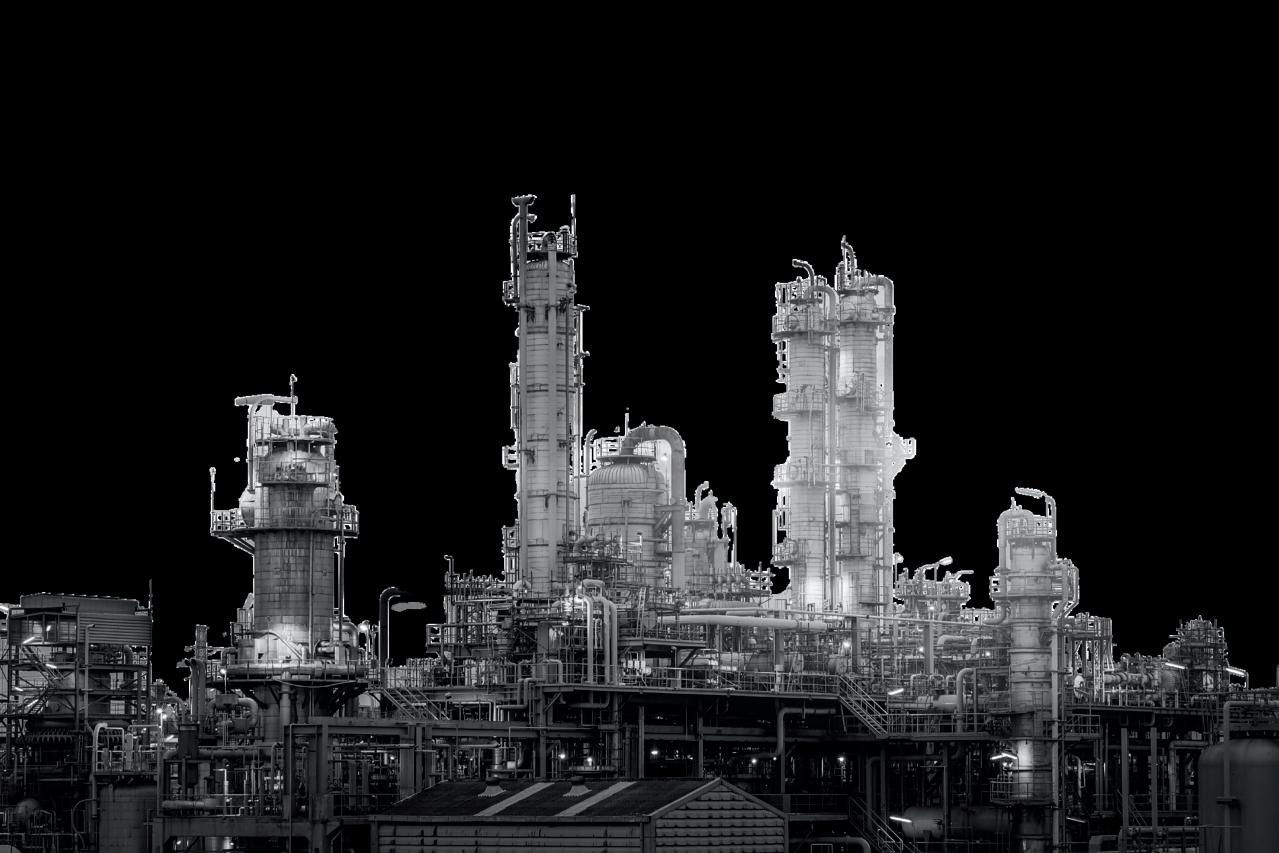





 Image 1. Digital collage of opportunities in the energetic transformation.
Image 1. Digital collage of opportunities in the energetic transformation.
Costa Rica Olas Verdes Hotel
Effort to decarbonization
Esfuerzo
para la descarbonización
Foreign investment in Costa Rica commenced in the late 19th century with the coffee industry. By the 1980s, the government incentivized foreign direct investment (FDI), spurring multinational engagement in technology and manufacturing. In the early 2000s, Costa Rica experienced a surge in FDI, leveraging its stable political environment, skilled workforce, and strategic location, particularly thriving in outsourcing services like tech and pharmaceuticals [1].
La inversión extranjera en Costa Rica comenzó a finales del siglo XIX con la industria del café. En la década de 1980, el gobierno incentivó la inversión extranjera directa (IED), lo que llevó a la participación multinacional en tecnología y manufactura. A principios de la década de 2000, Costa Rica experimentó un aumento en la IED, aprovechando su entorno político estable, fuerza laboral y ubicación estratégica, especialmente en servicios de externalización como tecnologías y farmacéuticas [1].

Costa Rica, the largest consumer of renewable energy in Central America, heavily relies on hydropower, though recent years have witnessed significant diversification into geothermal and wind energy. Notably, in 2015, the country operated solely on renewable energy for 299 consecutive days, emblematic of its commitment to sustainability and reducing fossil fuel dependence.
Costa Rica, el mayor consumidor de energía renovable en América Central, depende en gran medida de la energía hidroeléctrica, aunque en los últimos años ha habido una importante diversificación hacia la energía geotérmica y eólica. Notablemente, en 2015, el país operó únicamente con energía renovable durante 299 días consecutivos, ejemplo de su compromiso con la sostenibilidad y la reducción de la dependencia de los combustibles fósiles.


Moreover, Costa Rica’s public policy drives investments in renewables across sectors, as outlined in the National Decarbonization Plan (NDP) launched in 2018. With specific targets in transportation, energy, waste management, and agriculture, the NDP promotes electric vehicles, renewable energy expansion, public transportation improvement, forest conservation, and sustainable agriculture. It emphasizes collaboration among government, private sector, and civil society, with a focus on energy, including promoting electric vehicles, reducing industrial CO2 emissions, and ensuring widespread access to renewable electricity [2].
Además, la política pública de Costa Rica impulsa inversiones en energías renovables en todos los sectores, como se describe en el Plan Nacional de Descarbonización (PND) lanzado en 2018. Con objetivos específicos en transporte, energía, manejo de desechos y agricultura, el PND promueve vehículos eléctricos, expansión de energías renovables, mejora del transporte público, conservación forestal y agricultura sostenible. Se enfatiza la colaboración entre el gobierno, el sector privado y la sociedad civil, con un enfoque en la energía, incluida la promoción de vehículos eléctricos, la reducción de emisiones de CO2 industriales y garantizar el acceso generalizado a la electricidad renovable [2].
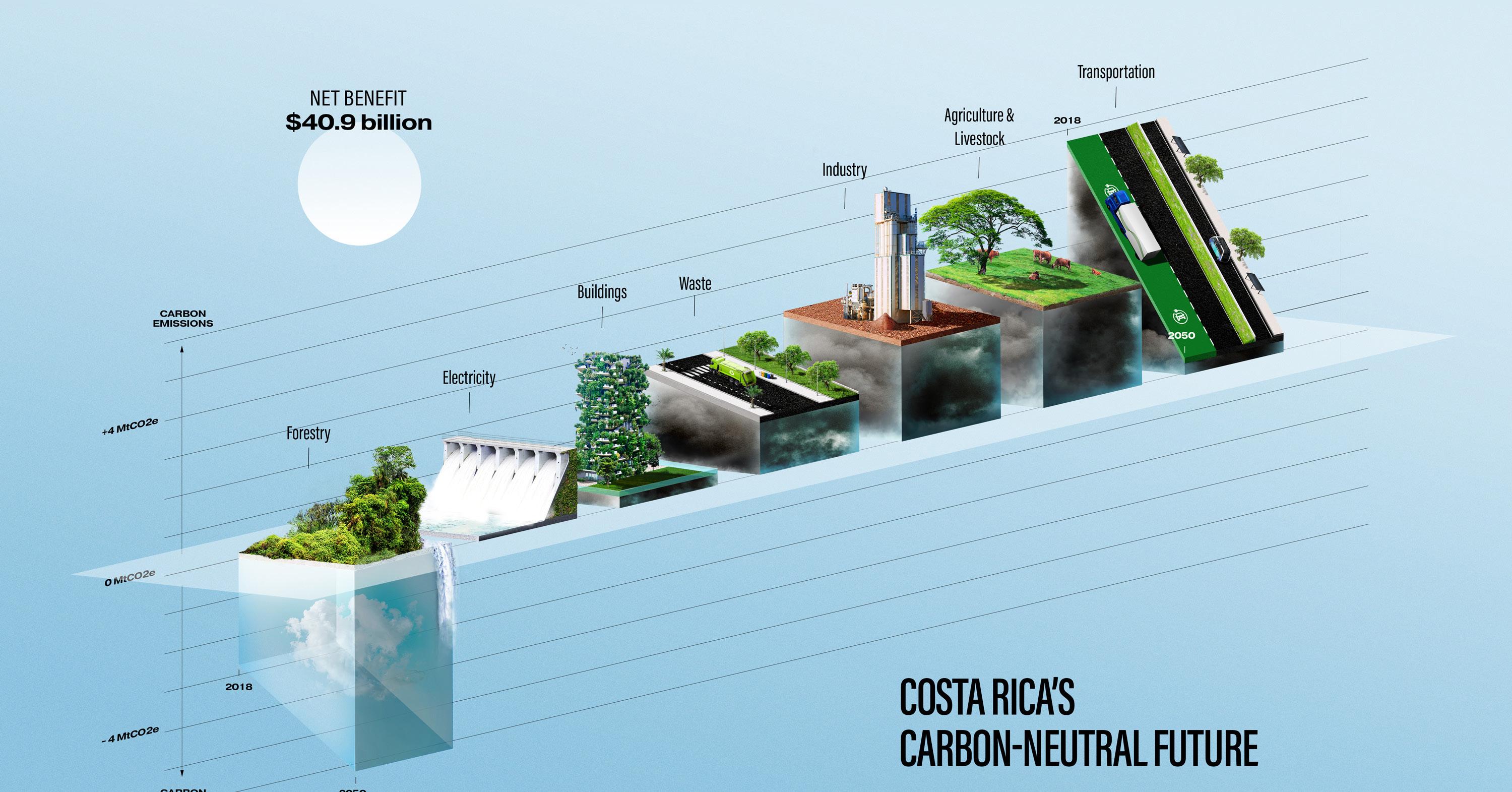

27
References:
[1]Costa Rica - Investment Climate Statement. (2024, 3 febrero). International Trade Administration | Trade.gov. https://www.trade. gov/country-commercial-guides/costa-rica-investment-climate-statement
[2]Gobierno de Costa Rica. (2018). National Decabonisation Plan. https://unfccc.int. Recuperado 16 de febrero de 2024, de https:// unfccc.int/sites/default/files/resource/NationalDecarbonizationPlan.pdf
Image 3: Energy Related axes in Costa Rica’s NDP (Self made) Image 4: Idustries and the total revenue of the NDP (Merité, 2020) Image 5: Costa Rica’s natinal CO2 Emissions comparative with and without the NDP (Acuña, 2022)Olas Verdes: a way to efficency
Olas Verdes: un camino a la eficiencia
Located in Nosara, Costa Rica, is renowned for its commitment to sustainability and eco-friendly practices. The hotel seamlessly integrates technology to enhance electric efficiency and utilize renewable energies. [1]
Ubicado en Nosara, Costa Rica, el Hotel Olas Verdes es reconocido por su compromiso con la sostenibilidad y prácticas respetuosas con el medio ambiente. El hotel integra tecnología de manera fluida para mejorar la eficiencia eléctrica y utilizar energías renovables. [1] Olas Verdes Hotel holds LEED Platinum certification, a prestigious recognition of its sustainable building practices and environmental stewardship. Achieving this certification required rigorous adherence to specific criteria set forth by the U.S. Green Building Council (USGBC). LEED is the principal certification in Costa Rica due to its alliance with the US. This certification implies that the building is at least 48 percent more energy efficient than a normal building it seizes, also that at the minimum it uses 13 percent of the electricity via renewable energy, in this case solar panels. [2]

Olas Verdes Hotel ostenta la certificación LEED Platino, un reconocimiento prestigioso a sus prácticas de construcción sostenible y liderazgo ambiental. Lograr esta certificación requirió una estricta adherencia a criterios específicos establecidos por el Consejo de Construcción Verde de Estados Unidos (USGBC). LEED es la principal certificación en Costa Rica debido a su alianza con los Estados Unidos. Esta certificación implica que el edificio es al menos un 48 por ciento más eficiente energéticamente que un edificio normal de su tamaño, y que como mínimo utiliza un 13 por ciento de electricidad mediante energía renovable, en este caso, paneles solares.[2]


Referencias:
[1] Olas Verdes Hotel - STOKE. (2018, 3 abril). STOKE. https://www.stokecertified.com/members/olas-verdes-hotel/ [2]Olas Verdes Hotel | U.S. Green Building Council. (2016, 1 julio). https://www.usgbc.org/pro jects/olas-verdes-hotel?view=overview [3]Mitsubishi Electric. (2022). OLAS VERDES HOTEL. www.mitsubishicomfort.com. Recuperado 16 de febrero de 2024, de https:// www.mitsubishicomfort.com/sites/default/files/2022-12/Case%20Study_SPA_Olas%20Verdes%20Hotel.pdf
The hotel significantly reduces energy consumption, evidenced by a reported energy savings of 35% compared to standard buildings of similar size. This is achieved through the installation of energy-efficient lighting, HVAC systems, and appliances. [3] El hotel reduce significativamente el consumo de energía, lo que se evidencia en un ahorro energético reportado del 35% en comparación con edificios estándar de tamaño similar. Esto se logra mediante la instalación de sistemas de iluminación, HVAC y electrodomésticos eficientes en energía.[3]
29


In addition, the hotel sources environmentally friendly materials, with over 50% of construction materials being regionally sourced and 20% being made from recycled content.
Asimismo, el hotel utiliza materiales respetuosos con el medio ambiente, con más del 50% de los materiales de construcción provenientes de fuentes regionales y un 20% fabricado con contenido reciclado.
This contributes to, at large, the building decreases the CO2 consumption in at leas 90% ofa standard hotel it size.
Esto contribuye, en gran medida, a que el edificio reduzca el consumo de CO2 en al menos un 90% en comparación con un hotel estándar de su tamaño.

 Image 9: Project’s Achived NPD axes (self made)
Images 10,11,12: Hotel Views (Prendas-Loria, 2017)
Image 9: Project’s Achived NPD axes (self made)
Images 10,11,12: Hotel Views (Prendas-Loria, 2017)
BIOMASS HEATING PLANT
What is Energy Biomass?
The addition of the green roof to the Hotchkiss School’s Biomass Treatment Center in July 2012 is an exhilarating enhancement to the campus in Lakeville, Connecticut. This newly constructed Biomass Treatment Center has achieved LEED Gold certification, signifying its adherence to high standards of energy efficiency and sustainable design. Notably, this facility is geared towards providing heating for the various buildings on the Hotchkiss School’s campus, showcasing a commitment to eco-friendly practices and renewable energy sources
La incorporación del techo verde al Centro de Tratamiento de Biomasa de la Escuela Hotchkiss en julio de 2012 es una mejora estimulante para el campus de Lakeville, Connecticut. Este Centro de Tratamiento de Biomasa de nueva construcción ha obtenido la certificación LEED Gold, lo que significa su cumplimiento de altos estándares de eficiencia energética y diseño sostenible. En particular, esta instalación está orientada a proporcionar calefacción a los distintos edificios del campus de la Escuela Hotchkiss, lo que demuestra un compromiso con las prácticas ecológicas y las fuentes de energía renovables
This initiative showcases the school’s dedication to sustainable practices and environmental responsibility in its energy consumption and overall operations.
Esta iniciativa muestra la dedicación de la escuela a las prácticas sustentables y la responsabilidad ambiental en su consumo de energía y operaciones generales.

ese include the incorporation of a renewable laminated wood structural system, water-conserving plumbing xtures, utilization of local materials with a signi cant recycled content, provision of ample natural daylight within the interior spaces, and implementation of highly e cient mechanical systems, lighting, and exterior skin. e emphasis on these eco-friendly elements re ects the project’s dedication to minimizing environmental impact and promoting energy e ciency throughout its design and construction. Estos incluyen la incorporación de un sistema estructural de madera laminada renovable, accesorios de plomería que ahorran agua, la utilización de materiales locales con un importante contenido reciclado, provisión de abundante luz natural dentro de los espacios interiores e implementación de sistemas mecánicos, de iluminación y exteriores altamente eficientes. piel. El énfasis en estos elementos ecológicos refleja la dedicación del proyecto para minimizar el impacto ambiental y promover la eficiencia energética en todo su diseño y construcción.

When viewed from the campus, the rhythmic façade of a building suggests various potential functions, such as a museum, classroom, or laboratory. However, it actually serves a crucial role as a biomass facility. is facility utilizes sustainably harvested wood chips to heat the Hotchkiss School, accommodating over 600 residents and comprising 85 buildings totaling 1.2 million square feet. Recognized as a carbon-neutral fuel by the International Panel on Climate Change, these locally sourced wood chips are derived from responsibly managed forests. ey e ectively replace approximately 150,000 gallons of imported fuel oil an-
Cuando se ve desde el campus, la fachada rítmica de un edificio sugiere varias funciones potenciales, como un museo, un aula o un laboratorio. Sin embargo, en realidad cumple un papel crucial como instalación de biomasa. Esta instalación utiliza astillas de madera recolectadas de manera sostenible para calentar la escuela Hotchkiss, que alberga a más de 600 residentes y comprende 85 edificios con un total de 1,2 millones de pies cuadrados. Estas astillas de madera de origen local, reconocidas como combustible neutro en carbono por el Panel Internacional sobre el Cambio Climático, provienen de bosques gestionados de forma responsable. Reemplazan efectivamente aproximadamente 150,000 galones de fueloil importado anualmente, lo que lleva a una reducción notable de las emisiones, particularmente de dióxido de azufre, en más del 90 por ciento.
31
nually, leading to a remarkable reduction in emissions, particularly sulfur dioxide by over 90 percent.

Referencias:
UN, 2013 Biomass Heating Plant. DE: https://centerbrook.com/project/hotchkiss_school_biomass_heating_facility Hotchkiss, 2024 Energy & Infrastructure DE: https://www.hotchkiss.org/our-school/environmental-initiatives/energy-infrastructure
Imágen 2: Biomass Heating Plant, Hotchkiss School (UN, 2015)
Imágen 3: Biomass Heating Plant, Hotchkiss School Caldera (UN, 2015)
Hotchkiss School: a way to efficency
Hotchkiss School in Lakeville, Connecticut, prioritizes a holistic approach to environmental education, encompassing the sciences, arts, and humanities. e school capitalizes on its natural surroundings for hands-on learning experiences, encouraging students to conduct eld research, participate in land conservation e orts, and connect various subjects to the environment.
La escuela Hotchkiss en Lakeville, Connecticut, prioriza un enfoque holístico de la educación ambiental, que abarca las ciencias, las artes y las humanidades. La escuela aprovecha su entorno natural para experiencias de aprendizaje prácticas, alentando a los estudiantes a realizar investigaciones de campo, participar en esfuerzos de conservación de la tierra y conectar diversos temas con el medio ambiente.


In pursuit of our target to achieve carbon neutrality by 2020, Hotchkiss has prioritized the development of green infrastructure. Despite expanding our building space by one-third in recent years, the campus has successfully reduced overall energy consumption by almost 20 percent. En pos de nuestro objetivo de lograr la neutralidad de carbono para 2020, Hotchkiss ha priorizado el desarrollo de infraestructura verde. A pesar de ampliar el espacio de nuestro edificio en un tercio en los últimos años, el campus ha reducido con éxito el consumo general de energía en casi un 20 por ciento.
Wind power accounts for 35 percent of our electricity, while approximately 95 percent of our heat and hot water are supplied by a central heating facility powered by wood chips. is contributes to about 40 percent of our total carbon footprint.
La energía eólica representa el 35 por ciento de nuestra electricidad, mientras que aproximadamente el 95 por ciento de nuestra calefacción y agua caliente provienen de una instalación de calefacción central alimentada por astillas de madera. Esto contribuye a aproximadamente el 40 por ciento de nuestra huella de carbono total.

Referencias:
2024 https://www.hotchkiss.org/our-school/environmental-initiatives/
(UN, 2015)



BAHNSTADT
The larggest passivhouse residential in the world in Heidelberg, Germany.
Heidelberg, city of knowledge.
Heidelberg is a committed city to caring for the environtment, climate protection and sustainability. This commitment to the energy transition and creating energy communities is carried out with the implementation of the Bahnstadt proyect, whis is the larggest Passivhouse in the world. Which has the full planning and political support of the local administration carried out by the Climate Protection Plan and Urban Planning supported by the 100% climate protection Master Plan.
Heidelberg es una ciudad comprometida con el cuidado del medio ambiente, la protección climática y la sostenibilidad puesto que es parte de las 96 ciudades comprometidas con la lucha contra el cambio climático denominadas ciudades C40. Además de ello en el 2022 se unió a la misión de la Unión Europea de llegar a ser una de las 100 ciudades climáticamente neutras, las cuales son ciudades que son ciudades con niveles de emisiones muy bajas o nulas. Este compromiso hacía la transición energética y crear comunidades energéticas se ve llevado acabo con la implementación del proyecto Bahnstadt, que es el proyecto Passivhaus más grande del mundo. El cual tienen el pleno apoyo político y de planeación de la administración local llevado acabo por el Plan de Protección Climática en la Planeación Urbana sustentado por el Plan Maestro 100% protección climática.


Heidelberg es parte de las ciudades C40. Heidelberg is engaged with the EU mission to be one of the hundred neutrals cities.
Heidelberg is part of the C40 cities.
Heidelberg esta comprometida para ser parte de las 100 ciudades neutrales de la UE.

29: 100% renewable europe report (LUT University, 2020)

Bahnstadt (Train city)
Bahnstadt is located in an abandoned reconversion area (areas intended for the use of pre-existing ones to generate a new use that creates profits) that was bought from the German company Deutsche Bahn, which was previously occupied by the old freight railway station southwest of the city. The aim of the project is to create a “city of knowledge” by creating a university and scientific city of regeneration, Net Zero and connectivity.
Bahnstadt esta ubicado en un área de reconversión (áreas destinadas al aprovechamiento de las preexistencias para generar un nuevo uso que cree beneficios) abandonada que fue comprada a la compañía alemana Deutsche Bahn, la cual antes estaba ocupada por la antigua estación del ferrocarril de carga al suroeste de la ciudad. El objetivo del proyecto es crear una “ciudad de conocimiento” creando una ciudad universitaria y científica de regeneración, Net Zero y conectividad.


Referencias: UN, 2014 La forma en que consumimos enegría. DE: www.energia.com
Program and equipments
e project has a total area of 116 hectares (1.16 km2) of mixed residential, commercial and public uses, of which 9 are habitable with 165 housing units of 5 to 8 oors each, 16.5 commercial, 22 campuses and 11 streets. It is expected to reach 6,800 inhabitants in 3,700 apartments, along with 6,000 employees.
It has a conference center, the world’s rst passive cinema (15 screens and outdoor areas), 8 kindergartens, a school for 3,300 students (150 per campus), 200 places in the civic community hall, 2.2 km tracks for the new tram line along with 3 new tram stops and 3.5 km of bicycle lanes, and has a energic plant with a heighth of 55 meters.
“a large combined heat and power plant powered by wood chips was built providing Bahnstadt with 24 million kWh of electricity and 80 million kWh of heating energy per year, enough to cover the energy demand of the entire district and reduce CO2 emissions to almost 0%”. (C40 org., 2015)
El proyecto cuenta con una área total de 116 hectáreas (1.16 km2) de usos mixtos residencial, comercial y público, de las cuales 9 son habitables con 165 unidades habitacionales de 5 pisos cada uno, 16,5 comerciales, 22 campus y 11 calles.
Se espera a llegar a 6,800 habitantes en 3,700 apartamentos, junto con 6,000 empleados.
Cuenta con un centro de conferencias, el primer cine a nivel mundial pasivo (15 pantallas y áreas al aire libre), 8 guarderías, escuela para 3,300 alumnos (150 por campus), 200 plazas en el salón de la comunidad ciudadana, vías de 2,2 km para la nueva línea de tranvía junto con 3 nuevas paradas del mismo, 3,5 km de carriles de bicicleta. “se construyó una gran planta combinada de calor y electricidad alimentada con astillas de madera que proporciona a Bahnstadt 24 millones de kWh de electricidad y 80 millones de kWh de energía de calefacción al año, suficiente para cubrir la demanda energética de todo el distrito y reducir las emisiones de CO2 a casi 0%”. (C40 org,2015)
Strategies to be a Net zero city.




All buildings are designed to have low or no energy consumption, guided by the principles of Passivhaus.
Todos los edificios están diseñados para tener un bajo o nulo consumo de energía, guiado por los principios de las Passivhaus.
Optimisation of energy supply: Nearby district cogeneration plant that generates fuel by means of biomass (wood chips from landscape management material).
Optimización del suministro energético: Central distrital de cogeneración cercana que genera combustible por medio de biomasa (astillas de madera procedentes de material de gestión paisajística).
Use of renewable energies such as wind and photovoltaic. Optimization of energy suply: district hearing.
Uso de energías renovables como la eólica y la fotovoltaica. Optimización del suministro energético: calefacción urbana.
Rainwater retention and reuse, minimizing wastewater drainage discharges.
Retención y reutilización de agua pluvial, minimizando las descargas de drenaje de aguas residuales.

It saved 30,000 tonnes of CO2 per year, making Heidelberg the largest zero emission district in Europe. Se ahorró 30 mil toneladas de CO2 al año los que hacen que Heidelberg sea el mayor distrito de emisiones cero de Europa.

38 Strategies to be a Net zero city.



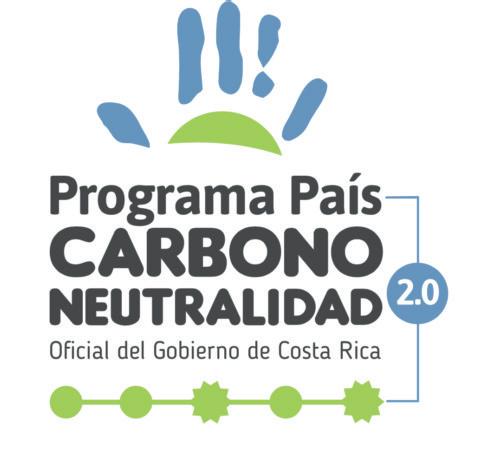


Imágen 1: Bahnstadt masterplan (Partner, 2018)
Áreas de
Bahnstadt (Train city)
2008 - 2022
116 Hectares terrain
9 thousand squares metes of habitational spaces
Warm temperate
Hight temp: 33°C
Mean Temp: 22°C
Low Temp: -0°C




90% less thermal energy









90% menos de energía térmica
50-70% water reuse
50-70% reutilización del agua
94% less carbon emissions
94% menos emisiones de carbono
In conclusion, while each project varies significantly in scale and context, a unifying theme emerges: a commitment to diversifying land usage to maximize sustainability. Despite their diverse locations and purposes, all projects share a common interest in obtaining international sustainability certifications and implementing net-zero programs tailored to their specific needs. Furthermore, despite differences in climate conditions, renewable energy sources are being leveraged across the board to promote energy efficient systems and reduce carbon footprints. This collective emphasis on sustainability underscores a global shift towards responsible development practices, wherein projects of varying scopes prioritize environmental impact alongside economic objectives. By embracing diverse approaches tailored to their unique contexts, these projects exemplify a commitment to building a more sustainable future, one that balances human needs with ecological preservation and energy efficiency on a global scale.
Referencias:
Passivhaus Austral | Proyectos certificados Passivhaus alrededor del mundo. (2021, 28 abril). https://www.passivhaus-austral.cl/2021/04/28/proyectos-certificados-passivhaus-alrededor-del-mundo/ Blick in die Bahnstadt - Bahnstadt Heidelberg. (s. f.). https://www.heidelberg.de/hd,Lde/990099.html
Bahnstadt Heidelberg von meyerschmitzmorkramer. (s. f.). caspar.archi. https://caspar.archi/de/projekte/alle-projekte/bahnstadt-heidelberg/ Flores, E. (2022, 28 enero). LUT 100 RENEWABLE EUROPE - H2News. H2news. https://h2news.cl/2022/01/28/lut-100-renewable-europe/ Partner, L. +. (2018, 28 febrero). Bahnstadt Heidelberg, DE. Baunetz Architekt*Innen. https://www.baunetz-architekten.de/latz-partner/2519299/ projekt/5129632
Iberdrola. (2021, 22 abril). CIUDADES C40. Iberdrola. https://www.iberdrola. com/compromiso-social/ciudades-c40
Influence Watch. (2023b, septiembre 12). C40 Cities Climate Leadership Group - InfluenceWatch. InfluenceWatch. https://www.influencewatch.org/ non-profit/c40-cities-climate-leadership-group/ Europa puede lograr la neutralidad climática antes de 2050 con un sistema de energía 100% renovable. (s. f.). https://smartenergyconsulting. blogspot.com/2020/04/europa-puede-lograr-la-neutralidad.html
Preziosa, L. L. (2019, 6 febrero). Lo studio LAVA per la transizione tangibile verso un’energia sostenibile. Architettura Ecosostenibile: Bioarchitettura E Sostenibilità. https://www.architetturaecosostenibile.it/architettura/progetti/studio-lava-transizione-energia-154
file:///C:/Users/arace/Downloads/Bahnstadt_un_proyecto_innovador_de_ urbanismo_Ribbeck_Exkhart_2019.pdf
Plan maestro 100% Klimaschutz - C40 Cities. (2022, 15 febrero). C40 Cities. https://www.c40.org/es/case-studies/masterplan-100-klimaschutz/ Monitoring in the Passive House district of Bahnstadt, Heidelberg [Passipedia EN]. (s. f.). https://passipedia.org/operation/operation_and_experience/ monitoring_in_the_passive_house_district_of_bahnstadt_heidelberg
2. REGIONAL CONTEXT
MEXICAN CONTEXT
Contexto Mexicano
Mexico belongs to the small group of oil and gas producing countries that can supply its national energy market and also export hydrocarbons to other countries. Oil has determined the economic and energy life of the country for many years, however, the idea that the oil bonanza will last for many years is not only wrong but has fueled political decisions that have determined its unsustainable exploitation. (Villarreal Padilla, n.d.)
México pertenece al reducido grupo de países productores de petróleo y gas que pueden abastecer su mercado nacional de energéticos y además exportar hidrocarburos a otros países. El petróleo ha determinado la vida económica y energética del país por muchos años, sin embargo, la idea de que la bonanza petrolera durará por muchos años no sólo está equivocada sino que ha alimentado decisiones políticas que han determinado su explotación no sustentable. (Villarreal Padilla, n.d.)
In 2022, Marcelo Ebrard, former Minister of Foreign Affairs of Mexico, pledged to reduce GHG emissions by 35% by 2030. However, according to the EMBER think tank, Mexico depends mainly on oil and gas, and 74% of its electricity is still generated through fossil fuels. (Alarcón, 2023)
El 2022, Marcelo Ebrard, ex ministro de Relaciones exteriores de México, se comprometió a reducir las emisiones de GEI un 35% para 2030, Sin embargo, según el grupo de expertos EMBER, México depende principalmente de petróleo y gas, y el 74 % de su electricidad todavía se genera a través de combustibles fósiles. (Alarcón, 2023)

Referencias:
Villarreal Padilla, J. (n.d.). Reforma energética, transición energética y cambio climático. Café Político. Retrieved February 16, 2024, from https://mx.boell.org/sites/default/files/cp_transicion_energetica_1.pdf Alarcón, A. (2023, November 28). Energy Transition in Mexico: The Renewable Energy Map to 2030. Mexico Business News. Retrieved February 16, 2024, from https://mexicobusiness.news/energy/news/energy-transition-mexico-renewable-energy-map-2030
In Mexico, the energy sector represents 3% of the national gross domestic product (GDP refers to the money that a country produces and charges for its work), and is the main source of public income. (ADN opinion, 2023) En México el sector energético representa el 3% del producto interno bruto nacional ( PIB se refiere a el dinero que un país produce y cobra por su trabajo), y es la principal fuente de ingresos públicos. (ADN opinion, 2023)

Referencias: ADN opinion. (2023, Mayo 18). Transición energética en México. YouTube: Home. Retrieved February 16, 2024, from https://youtu. be/650Qc7bhZYE?si=S2dDH5BEmVWbmINi
REGULATORY FRAMEWORK
El Marco Regulatorio
To achieve a successful energy transition and catch up with advanced economies, Mexico needs to modernize its energy sector, reduce dependence on fossil fuels and ensure sustainability. To this there are actions that are proposed and being carried out by government institutions, reforms and global agreements. (Alarcón, 2023)
Para lograr una transición energética exitosa y ponerse al día con las economías avanzadas, México necesita modernizar su sector energético, reducir la dependencia de los combustibles fósiles y garantizar la sostenibilidad. Para lograr esto existen acciones que se están llevando a cabo por parte de instituciones gubernamentales, reformas y acuerdos globales. (Alarcón, 2023)
It is responsible for supplying electricity to the nation It is a productive state company, exclusively owned by the federal government, with legal personality and its own assets. (Nuestra Empresa, n d.)
Se encarga de proveer energía eléctrica a la nación. Es una empresa productiva del Estado, propiedad exclusiva del gobierno federal, con personalidad
jurídica y patrimonio propio. (Nuestra Empresa, n d.)

Electricity Commission)
C F E ( F e d
C F E Government Institutions Instituciones gubernamentales
CONUEE(Comisiónnacional para el u s o e c etnei ed grene)aí

CONUEE(NationalCommission f or th e e c i e n t u es o f ygrene )
CRE(Comisión reguladora de energía)
CRE(Energy Regulatory Commission)
Diagrama 1: Fuente elaboración propia con base en (Comisión Nacional Para El Uso Eficiente De La Energía - ¿Qué Hacemos?, n.d.), (Nuestra Empresa, n d.) y (Comisión Reguladora De Energía | Gobierno | Gob.mx, n.d.)
Referencias:

In terms of institutions, we have the CONUEE (national commission for the efficient use of energy), which aims to promote energy efficiency and consolidate itself as a technical organization in the field of sustainable use of energy. It was created through the Energy Transition Law published in the Official Gazette of the Federation on December 24, 2015. (Comisión Nacional Para El Uso Eficiente De La Energía - ¿Qué Hacemos?, n.d.)
En cuanto a instituciones tenemos a la CONUEE (comisión nacional para el uso eficiente de energía) que tiene por objeto promover la eficiencia energética y constituirse como órgano de carácter técnico en materia de aprovechamiento sustentable de la energía, fue creada a través de la Ley de Transición Energética publicada en el Diario Oficial de la Federación el 24 de diciembre del 2015. isión Nacional Para El Uso Eficiente De La Energía¿Qué Hacemos?, n.d.)
It is in charge of exercising the powers and dispatching the matters entrusted to it by the Law of Coordinated Regulatory Bodies in Energy Matters, the Hydrocarbons Law, the Electrical Industry Law, the Energy Transition Law and the General Law. of Climate Change. The CRE is endowed with technical, operational and management autonomy, and has its own legal personality. (Comisión Reguladora De Energía | Gobierno | Gob.mx, n.d.)
Tiene a su cargo el ejercicio de las atribuciones y el despacho de los asuntos que le encomiendan la Ley de los Órganos Reguladores Coordinados en Materia Energética, la Ley de Hidrocarburos, la Ley de la Industria Eléctrica, la Ley de Transición Energética y la Ley General de Cambio Climático.
La CRE está dotada de autonomía técnica, operativa y de gestión, y cuenta con personalidad jurídica propia. (Comisión Reguladora De Energía | Gobierno | Gob.mx, n.d.)
Alarcón, A. (2023, November 28). Energy Transition in Mexico: The Renewable Energy Map to 2030. Mexico Business News. Retrieved February 16, 2024, from https://mexicobusiness.news/energy/news/energy-transition-mexico-renewable-energy-map-2030 Comisión Nacional para el Uso Eficiente de la Energía - ¿Qué hacemos? (n.d.). Gobierno de México. Retrieved February 16, 2024, from https:// www.gob.mx/conuee/que-hacemos
Comisión Reguladora de Energía | Gobierno | gob.mx. (n.d.). Gobierno de México. Retrieved February 16, 2024, from https://www.gob.mx/cre/ que-hacemos
Nuestra Empresa. (n.d.). CFE. Retrieved February 16, 2024, from https://www.cfe.mx/nuestraempresa/pages/queeslacfe.aspx
THE ENERGY REFORM
La Reforma Energética
The energy reform establishes a minimum participation of 35% of clean energy in the generation of electrical energy by 2024 and establishes as one of its main objectives to promote the sustainable development of the electricity industry, as well as compliance with the public and universal service obligations of Clean Energy and the reduction of polluting emissions. (AMDEEE, 2005)
La reforma energética establece una participación mínima de 35% de energías limpias en la generación de energía eléctrica para el 2024 y establece como uno de sus principales objetivos el promover el desarrollo sustentable de la industria eléctrica, así como el cumplimiento de las obligaciones de servicio público y universal de Energías Limpias y de reducción de emisiones contaminantes. (AMDEEE, 2005) GOALS





Offers guarantees to participants in the electricity market. Ofrece garantías a los participantes en el mercado eléctrico
Complements the purpose and operation of the Clean Energy Certificates established in the LIE (Electrical Industry Law). Complementa el objeto y operación de los Certificados de Energía Limpia establecidos en la LIE (Ley de la industria eléctrica)
Facilitates private investments in clean energy. Facilita las inversiones privadas en energía limpia.
Reduces the country’s dependence on fossil fuels as a source primary energy.
Reduce la dependencia del país de los combustibles fósiles como fuente primaria de energía.
Promotes the energy efficiency policy by strengthening the instruments and competencies of the institutions in charge of the subject.
Impulsa la política de eficiencia energética al fortalecer los instrumentos y competencias de las instituciones encargadas del tema.

Contributes to combating climate change by reducing between 80 and 100 million tons of CO2 annually. Contribuye a combatir el cambio climático al reducir entre 80 y 100 millones de toneladas de CO2 anualmente.
Diagrama 2: Fuente elaboración propia con base en (AMDEEE, 2005)
Referencias: AMDEEE. (2005, Octubre 7). Transición Energética: elemento clave frente al cambio climático. Senado de la República. Retrieved February 16, 2024, from https://www.senado.gob.mx/comisiones/cambio_climatico/reu/docs/presentacion2_071015.pdf
PARIS AGREEMENT
El Acuerdo de París
The Paris Agreement is a milestone in the climate change process because for the first time, a binding agreement brings all countries together in a common cause to combat climate change and adapt to its effects. Its goal is to limit global warming to well below 2°C, preferably 1.5°C degrees Celsius.
Mexico was one of the first countries to ratify said agreement; being one of the 175 countries that signed the Paris Agreement, which was ratified by the Senate of the Republic. (Acuerdo De París: 5 Acciones De México | Presidencia De La República EPN | Gobierno | Gob.mx, n.d.)
El Acuerdo de París es un hito en el proceso del cambio climático porque por primera vez, un acuerdo vinculante hace que todos los países se unan en una causa común para combatir el cambio climático y adaptarse a sus efectos.
Su objetivo es limitar el calentamiento mundial a muy por debajo de 2°C , preferiblemente a 1,5°C grados centígrados.
México fue de los primeros países en ratificar dicho convenio; siendo uno de los 175 países que firmaron el Acuerdo de París, que fue ratificado por el Senado de la República. (Acuerdo De París: 5 Acciones De México | Presidencia De La República EPN | Gobierno | Gob.mx, n.d.)
Actions to comply with the Paris Agreement: Acciones para cumplir con el Acuerdo de París:
Improve the adaptive capacity of the 160 most vulnerable municipalities. These These are found mainly in Oaxaca, Guerrero and Michoacán.
Mejorar la capacidad adaptativa de los 160 municipios más vulnerables. Estos se encuentran sobre todo en Oaxaca, Guerrero y Michoacán.
Achieve a zero deforestation rate.
Alcanzar una tasa cero de deforestación.
Increase the resilience of the country’s strategic infrastructure and ecosystems. Aumentar la resiliencia de la infraestructura estratégica del país y de los ecosistemas.
Protect the population from extreme hydrometeorological phenomena.
Proteger a la población de los fenómenos hidrometeorológicos extremos.
Decouple economic growth from the emission of greenhouse pollutants.
Desacoplar el crecimiento económico de la emisión de contaminantes de efecto invernadero.
Diagrama 3: Fuente elaboración propia con base en (Acuerdo De París: 5 Acciones De México | Presidencia De La República EPN | Gobierno | Gob.mx, n.d.)
Referencias:
https://www.gob.mx/epn/articulos/5-comprimisos-de-mexico-con-el-acuerdo-de-paris Acuerdo de París: 5 acciones de México | Presidencia de la República EPN | Gobierno | gob.mx. (n.d.). Gobierno de México. Retrieved February 16, 2024, from https://www.gob.mx/epn/articulos/5-comprimisos-de-mexico-con-el-acuerdo-de-paris
PARIS AGREEMENT El Acuerdo de París
Acording to (Avance Del Cumplimiento De Los Compromisos Internacionales De México Para Combatir El Cambio Climático - CEMDA, n.d.)
Regarding general goals, Mexico’s specific goals for 2030 are:
Reduce the volume of black carbon emissions by 51%.
Reduce your Greenhouse Gas (GHG) emissions by 22%.
Esto en cuanto a metas generales, las metas específicas de México para el 2030 son*:
Reducir en 51% el volumen de las emisiones de carbono negro.
Reducir en 22% sus emisiones de Gases Efecto Invernadero (GEI).









Generate 35% clean energy by 2024 and 43% by 2030.
Generar el 35% de energía limpia para el 2024 y 43% para el 2030.
Reduce methane leaks and controlled burning by 25%.
Reducir en 25% las fugas y quemas controladas de metano.
Control black soot particles in industrial equipment and facilities.
Controlar las partículas negras de hollín en equipos e instalaciones industriales.
Supply ultra-low sulfur gasoline and diesel.
Abastecer de gasolinas y diésel de ultra bajo azufre.
Increase the natural gas vehicle fleet and have clean fuels. Incrementar la flota vehicular a gas natural y disponer de combustibles limpios.
Modernize the vehicle fleet and reduce the importation of used cars.
Modernizar el parque vehicular y reducir la importación de automóviles usados.
Promote the construction of buildings and the transformation towards sustainable cities, with energy efficiency and low carbon.
Impulsar la construcción de edificaciones y la transformación hacia ciudades sustentables, con eficiencia energética y bajo carbono.
Improve forest management and achieve zero deforestation rate by 2030.
Mejorar el manejo forestal y alcanzar tasa cero de deforestación al 2030.
Promote sustainable modernization of the countryside, promote biodigesters on agricultural farms and recover pastures.
Impulsar la tecnificación sustentable del campo, promover biodigestores en granjas agropecuarias y recuperar pastizales.
Referencias: Avance del cumplimiento de los compromisos internacionales de México para combatir el cambio climático - CEMDA. (n.d.). CEMDA. Retrieved February 16, 2024, from https://www.cemda.org.mx/avance-del-cumplimiento-de-los-compromisos-interna
ENERGY POVERTY
La Pobreza Energética
We know that Mexico is a developed country, which means that in several cases it does not have the equipment to be able to follow the list of actions that must be done for the compliance with the goals throughout the territory, in energy matters we can speak of that even in several parts of the territory Mexico suffers from energy poverty.
(Servicios Energéticos, Pobreza Energética Y Eficiencias Energética, Una Perspectiva Desde México., 2022)
According to (Ocampo, 2023), it is estimated that 36.7% of Mexican households experience energy poverty.
Energy poverty can be defined as the situation suffered by households that cannot afford sufficient energy services to satisfy their domestic needs and/or are forced to allocate an excessive part of their income to cover the energy costs of their homes. (Servicios Energéticos, Pobreza Energética Y Eficiencias Energética, Una Perspectiva Desde México., 2022)


Sabemos que México es un país en vías de desarrollo, lo que significa que en varios casos no se cuenta con el equipamiento para poder seguir la lista de acciones que se deben de hacer para el cumplimiento de las metas en todo el territorio, en materia energética podemos hablar de que incluso en varias partes del territorio México sufre de pobreza energética. (Servicios Energéticos, Pobreza Energética Y Eficiencias Energética, Una Perspectiva Desde México., 2022) De acuerdo (Ocampo, 2023), se estima que el 36.7% de los hogares mexicanos viven la pobreza energética.
La pobreza energética puede definirse como la situación que sufren los hogares que no pueden permitirse servicios energéticos suficientes para satisfacer sus necesidades domésticas y/o se ven obligados a destinar una parte excesiva de sus ingresos a cubrir los costes energéticos de sus hogares. (Servicios Energéticos, Pobreza Energética Y Eficiencias Energética, Una Perspectiva Desde México., 2022)
Referencias: Servicios energéticos, pobreza energética y eficiencias energética, una perspectiva desde México. (2022, March 22). Gobierno de México. Retrieved February 16, 2024, from https://www.gob.mx/cms/uploads/attachment/file/710897/Cuaderno8_PobrezaEnerg_tica_V140322.pdf
ENERGY POVERTY
La Pobreza Energética
Some studies estimate that 36.7% of households in Mexico suffer from energy poverty, which implies that approximately 46.6 million Mexicans do not have full access to quality energy, whether fuel or electricity.
Algunos estudios estiman que 36.7% de los hogares en México sufren pobreza energética, lo que implica que aproximadamente 46.6 millones de mexicanos no tienen acceso pleno a energía de calidad, ya sea combustible o electricidad.
A household in conditions of energy poverty is someone who spends 10% or more of their income per year on energy bills to cover basic energy services. Statistical evidence published by INEGI in 2016 indicates that in Mexico more than 10.6% of the total Households allocate more than 10% of their income to the energy bill, which implies that around 3.5 million homes were in that condition.
En un hogar en condiciones de pobreza energética es alguien que gasta 10% o más de sus ingresos al año en facturas de energía para cubrir servicios energéticos básicos, la evidencia estadística publicada por el INEGI en 2016 indica que en México más del 10.6% del total Los hogares destinan más del 10% de sus ingresos a la factura energética, lo que implica que alrededor de 3,5 millones de hogares se encontraban en esa condición.

Imágen 1: Elaboración propia con base en (Servicios Energéticos, Pobreza Energética Y Eficiencias Energética, Una Perspectiva Desde México., 2022) basado en Enich, INEGI
Referencias: Servicios energéticos, pobreza energética y eficiencias energética, una perspectiva desde México. (2022, March 22). Gobierno de México. Retrieved February 16, 2024, from https://www.gob.mx/cms/uploads/attachment/file/710897/Cuaderno8_PobrezaEnerg_tica_V140322.pdf
VULNERABLE GROUPS
Grupos Vulnerables
This fight is not only about decarbonization but also about the adaptation of the population to climate challenge. However, how can communities join this adaptation if they do not even have the economy to have access to the energy necessary to adapt to change climate and have a good quality of life?
Esta lucha no sólo se trata de la descarbonización sino también de la adaptación de la población al cambio climático, sin embargo, ¿Cómo las comunidades pueden sumarse a esta adaptación si ni siquiera tienen la economía para tener acceso a la energía necesaria para adaptarse al cambio climático y tener una buena calidad de vida?
In the communities located in the western portion of the border where the Sonoran and Chihuahua deserts are located, they are considered dry lands. These regions are characterized by high stress and severe resource degradation due to migration, desertification, high temperatures and toxicity of land, aquatic and air resources. (Barquero Diaz-Barriga & Barnhart, n.d.)
En las comunidades ubicadas en la porción occidental de la frontera donde se ubican los desiertos de Sonora y Chihuahua, se consideran tierras secas. Estas regiones se caracterizan por un alto estrés y una grave degradación de los recursos debido a la migración, la desertificación, las altas temperaturas y la toxicidad de los recursos terrestres, acuáticos y aéreos.


Imágen 4: Representación gráfica estado de Chihuahua y Sonora
Referencias:

Imágen 3: Representación gráfica República Mexicana
In this territory, electricity demand increases as a result of cooling needs due to higher temperatures, as well as increased demand for water pumping due to reduced availability of surface and shallow water resources. Additionally, this increase in electricity demand peaks more frequently, putting power transmission and distribution infrastructure at risk. (Barquero Diaz-Barriga & Barnhart, n.d.)
En este territorio la demanda de electricidad aumenta como resultado de las necesidades de refrigeración debido a las temperaturas más altas, así como de la mayor demanda de bombeo de agua debido a la menor disponibilidad de recursos de aguas superficiales y poco profundas. Además, este aumento en la demanda de electricidad alcanza su punto máximo con mayor frecuencia, poniendo en riesgo la infraestructura de transmisión y distribución de energía.
Barquero Diaz-Barriga, V., & Barnhart, A. (n.d.). Sustainable Energy Through Design: An Approach to Alleviate Energy Poverty in Vulnerable Communities on the US–Mexico Border Region. Check for updates. Retrieved February 16, 2024, from https://drive. google.com/drive/u/0/folders/1-DqWgdDHv-iAG8MWqb1KIwJw9WUaWKB1
VULNERABLE GROUPS
Grupos Vulnerables
It is also worth mentioning that the intensification of migration has driven the formation and growth of communities that do not meet the necessary elements to satisfy the well-being of their inhabitants, causing social vulnerability on both sides of the border, but increasingly on the Mexican side. The same occurs in states with similar climatic qualities, which are mostly also located in the border area, which creates vulnerable communities. (Barquero Diaz-Barriga & Barnhart, n.d.)
Cabe mencionar en adición que la intensificación de la migración ha impulsado la formación y crecimiento de comunidades que no reúnen los elementos necesarios para satisfacer el bienestar de sus habitantes, provocando vulnerabilidad social en ambos lados de la frontera, pero cada vez más en el lado mexicano.
Lo mismo ocurre en estados con cualidades climáticas similares, que en su mayoría también se encuentran en la zona fronteriza lo cuál crea comunidades vulnerables. (Barquero Diaz-Barriga & Barnhart, n.d.)
Vulnerability arises from the lack of environmental, social and economic assets to develop resilience and adaptive capacity. In this sense, for our projects, as architects, we think that the lack of urban design projects and planning programs related to the efficient and sustainable production of energy have direct consequences on the ability of communities to adapt to the climate and have better quality. of life. (Barquero Diaz-Barriga & Barnhart, n.d.)

Imágen 5: Representación bandera de México
Referencias:

La vulnerabilidad surge de la falta de activos ambientales, sociales y económicos para desarrollar resiliencia y capacidad de adaptación. En este sentido, para nuestros proyectos, como arquitectos pensemos que la falta de proyectos de diseño urbano y programas de planificación relacionados con la producción eficiente y sostenible de energía tienen consecuencias directas sobre la capacidad de las comunidades para adaptarse al clima y tener una mejor calidad de vida. (Barquero Diaz-Barriga & Barnhart, n.d.)
Barquero Diaz-Barriga, V., & Barnhart, A. (n.d.). Sustainable Energy Through Design: An Approach to Alleviate Energy Poverty in Vulnerable Communities on the US–Mexico Border Region. Check for updates. Retrieved February 16, 2024, from https://drive. google.com/drive/u/0/folders/1-DqWgdDHv-iAG8MWqb1KIwJw9WUaWKB1
3. LOCAL CONTEXT
3.1. POLITICS
Historic impact on urban lifestyle and energy regulations
1904 Se establece azcapotzalco como zona industrial con industria extranjera.
1905 Construcción de la hidroeléctrica de Necaxa.
1929 Ignaguración de la colonia Industrial Vallejo.
1928-1946 Planificación económica por el pruito de planificar.
1930 Ley sobre planeación general de la República.
1927 Centro de almacenamiento y distribución cd petroleo de la Colonia vallejo.
1870-1891 “Orden y progreso” Construcción de las vías del tren: - México-Veracrúz. - Paso del Norte.
1937 Creación de la CFE
1933 Fundación de la refinería de Azcapotzalco.
1930 Expropiación de terrenos para la construcción de la refinería de Azcapotzalco.

1959-1970 Planificación económica hacia cambios estructurales.
1947-1958 Planificación conómica como base para obtener prestamos internacionales.
1946-1958 Secretaría de bienes nacienales he inspección.
1947 Construcción de la planta de energía de Vallejo.
1961 Exploción de la refinería de Azcapotzalco.
1947 Construcción de la colonia Industrial Vallejo.
1938 Nacionalización de la refinería de Azcapotzalco.
1960 Nacionalización del Sistema Eléctrico.
1947 Ampliación de la refinería de Azcapotzalco.
1990-1994 Actuaización al programa nacional de desarrollo urbano.
1983 Actualización al Plan nacional de desarrollo urbano
1993 Actualización ley de asentamientos humanos.
1985 Primer censo de la República.
1978 Plan nacional de desarrollo urbano
1983 Actualización a la ley de planeación.
1976 Ley general de asentamientos humanos.
1977-1982 Planificación económica al revéz.
1971-1976 Planificación económica en un gobierno de “transición”.
1992 Programa de 100 ciudades.
1990 Censo de la República.
1989-1994 Plan nacional de desarrollo.
1984-1988 Programa nacional de desarrollo urbano y vivienda.
1995-2000 Plan nacional de desarrollo (social).
1992 Secretaría de desarrollo social participa en la planeación.
1982-1994 Secretaría de Minas e Industria Paraestatal.
1958-1976 Secretaría del Patrimonio Nacional.
1976-1982 Secretaría del Patrimonio y Fomento Industrial.
1975 Se incendia la refinería de Azcapotzalco.
2019
2005 Plan de desarrollo urbano de la Alcaldía de Azcapotzalco. .
2020-2050 Plan de desarrollo urbano de la Alcaldía de Azcapotzalco..
1994-HOY Secretaría de Energía.
1999 Reforma al artículo 27 y 28 de la Constitución Mexicana.
1991 Cierre de la refinería de Azcapotzalco.
1992 Modificación a la Ley del Servicio público de energía eléctrica.
1983 Co-generación de emergencia.
1975 Ley del Servicio público de energía eléctrica. (Autogeneración)
2013 Reforma energética de Peña Nieto. 2021 Reforma energética de López Obrador.
What would happen with different regulations?
In a world full of regulations, the ability to imagine different scenarios where you can explore the different possibilities of the world we are living in. Reality is a continuous process; it is not something stable; it can be changed throughout our actions. It is our responsibility to understand and imagine the world we want to live in the near future.

En un mundo lleno de regulaciones, la capacidad de imaginar diferentes escenarios donde puedas explorar las diferentes posibilidades del mundo en el que vivimos. La realidad es un proceso continuo; no es algo estable; puede cambiar a través de nuestras acciones. Es nuestra responsabilidad entender e imaginar el mundo en el que queremos vivir en un futuro cercano.

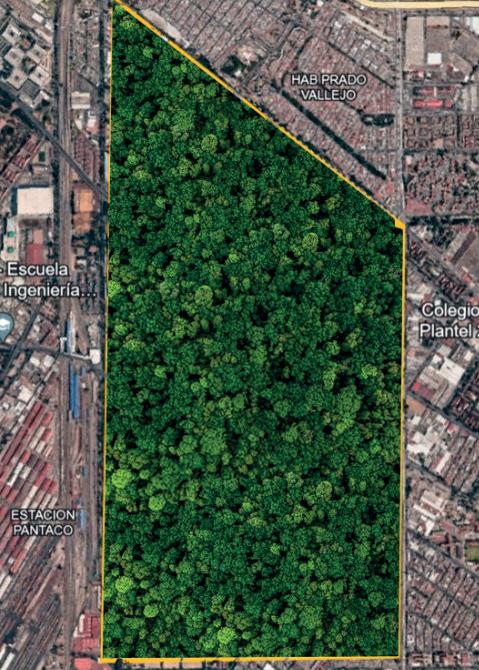

ENERGÍA


ACTORS IN THE ENERGY TRANSITION OF VALLEJO
The current government of Mexico City has plans prepared for the future of Vallejo, among these the Vallejo-i project, an innovative project with the objective of rehabilitating the industrial zone, promoting economic development, the use of new technologies and industrial innovation to contribute to economic growth based on better quality and sustainability standards. The project consists of four phases that serve different sectors:
1) Improvement of the environment and public infrastructure
2) Promotion of innovation and technological development
3) Urban planning and territorial planning
4) Economic development and job creation.
El gobierno de Ciudad de México tiene planes para el futuro de Vallejo, dentro de estos el proyecto de Vallejo-i, un proyecto de innovación con el objetivo de la rehabilitación de la zona industrial impulsando el desarrollo económico,nuevas tecnologías e innovación industrial para contribuir al crecimiento económico basado en mejores estándares de calidad y sustentabilidad. Este consiste en cuatro fases que atienden diferentes sectores.
Among the actions planned in these phases there has been several that have boost in a positive way the energy transition and decarbonization, some of these actions are:
Gradual replacement of the public lighting network with LEDs
Improvements in drainage and drinking water network
Azcapotzalco Transfer Station and Sorting Plant: performs mechanical separation by type of waste Recycling Center for construction and deconstruction wastes
Increase in green mass: planting trees and plants on the streets and adding green walls and terraces
Treated waters treatment plants and rainwater collection systems.
Monitoring and warning network for atmospheric pollutants
CDIT (Development center for innovation and technology)
Currently, the possibility of including a system for the use of solar energy is being evaluated.
Dentro de las acciones planeadas en estas fases ha habido un impulso a la transición energética y la descarbonización, algunas de estas acciones han sido: substitución paulatina de la red de alumbrado público por LED, mejoras en red de drenaje y agua potable, Estación de Transferencia y Planta de Selección Azcapotzalco, Centro Integral de Reciclaje de Residuos de la Construccion y Demolicion, aumento de masa verde plantas de tratamiento de aguas residuales y de sistemas de captación de agua pluvial, red de monitoreo y alerta por contaminantes atmosféricos, CDIT (Centro de Desarrollo e Innovación Tecnológica). Actualmente, se está evaluando la posibilidad de incluir un sistema para el aprovechamiento de la energía solar
Jefa de Gobierno
La inversión nal del proyecto es de 25,000 MDP
Inversión
Coordinadores
Constituido para la captación, inversión y administración de recursos y conformado por el gobierno de la ciudad, la alcaldía Azcapotzalco y la Asociación Industrial Vallejo, A. C.
Fideicomiso
Gobierno, Iniciativa privada, Academia, Ciudadanía
Empresas Inversionistas
Bimbo centro distribuidor: Uso de transporte eléctrico en la zona, donación para luminarias e inversión en logística y distribución 2022
Barcel: Uso de transporte eléctrico en la zona
Estafeta: Donación para luminarias
Honeywell: Inversión en logística y distribución 2022
Neolpharma: Inversión en logística y distribución 2022
Park Vallejo: Inversión en logística y distribución 2022
O´Donnell: Inversión en logística y distribución 2022
Alpla: Inversión en logística y distribución 2022
Áximo: Inversión en logística y distribución 2022
Prologys Chrysler: Inversión en logística y distribución 2022
SECTEI
SECRETARIA DE EDUCACIÓN, CIENCIA, TECNOLOGÍA E INNOVACIÓN
CENTRO DE DESARROLLO E INNOVACIÓN TECNOLÓGICA
Promueve la responsabilidad ambiental, el desarrollo urbano sostenible y la investigación de energías renovables.
JOSÈ BERNARDO ROSAS FERNÁNDEZ
POLITICS CONCLUSION
“Ordenyprogreso”Construcción delavíadeltrenPasodelnorte.11870-1891
The plans for Vallejo
A project that involves strategies, public policies of territorial planning, instruments and projects that intend to contribute to the rescue, strengthening and modernization of Azcapotzalco in a sustainable manner.
Within the PPDU, Vallejo-i is an innovative project designed to rehabilitate the industrial zone of Vallejo that consists of four phases:
-Improvement of the environment and public infrastructure
-Promotion of innovation and technological development
-Urban and territorial planning
-Economic development and job creation
(FG )Federal Government: Andres Manuel Lopez Obrador
(GM )Government of Mexico City: Marti Batres
(GA) Government of the Mayor's O ce of Azcapotzalco: Margarita Saldaña
(I) Industries in Vallejo
(FI) Future investors
(CE) Coordinators and escrow
(R) Residents
(NM) Neighboring municipalities
(FP) Floating population

The graph shows how the actors who benefit most from these projects are the government and industries, due to their economic interests in it, when the floating po ion and residents, have no influence on the decisions yet they are the ones it affects the most.
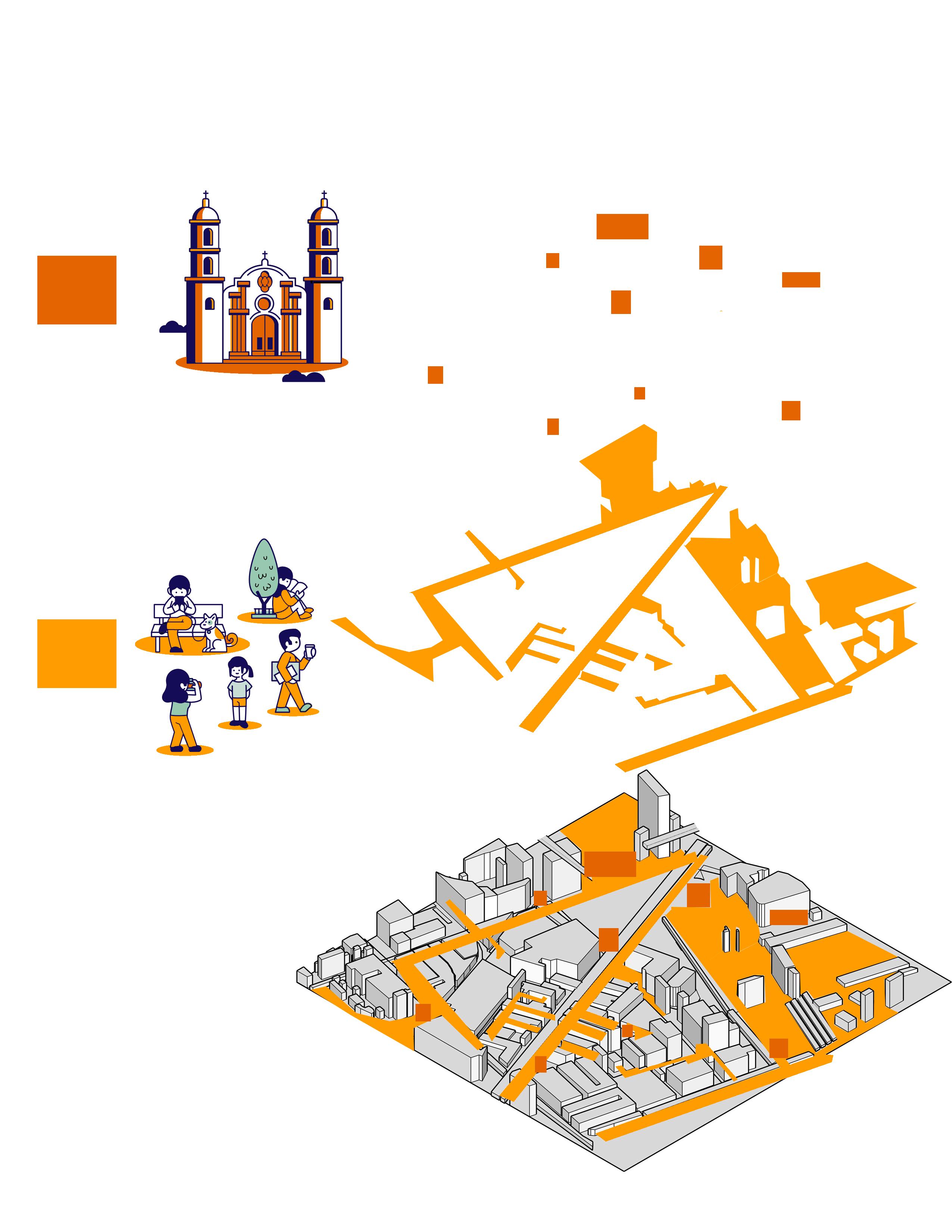

Fundacióndelcentrode almacenamientoydistribucióndepetroleodeVallejo.31927 Ignaguracióndelacoloniaindustrial Vallejo.1929 4 Fundacióndelarefineríade Azcapotzalco.51933
Energetic Reform ART.25 ART.27 ART.28
The CFE is a state organization with legal personality and its own assets and is responsible for the national electrical system. CFE controls the dispatch of electricity CENACE, which used to be independent
The transmission, generation, conduction and distribution of electricity are exclusive areas of the Nation.
There is a possibility of assignments or contracts with private parties.
The CFE will generate at least 54% and private companies 46% of the electricity Oil and gas exploration and extraction activities are exclusive to the State.


POLITICS OPORTUNITIES
Top-Bottom decision making porblems by sector.
Goverment
• Has the most amount of power and influence over the decisions taken.
• Tends to centralice power
• Focused on investments and economic growth for the state.
• Corruption vulnerability
• Changes in the advisory board due to problems by the political parties
Private Sector
• In search of their own economic benefit.
• Most of the investments is going towards logistics and mobility rather than social causses
• Lack of use of clean energy for industries
• Restricted by the energetic reform
Society
• The planning for new homes lacks decent conditions, with access to resources such as water and good mobility.
• Lack of representation in decision making
Territory
• By 2022, 35 new companies were inaugurated in Vallejo, further limiting recreational spaces and green areas.
• There are no plans to expand green areas and the minimum effort is made to incorporate these into the city

Lugar 37 de 41 paíces en coeficiente GINI (IMCO, 2022)

Se registran al menos 91 asesinatos díarios en México (Expanción, 2022)

Aproximadamente 1/4 de las personas de Azcapotzalco viven en situación de inseguridad Social. (Ecelsior, 2023)

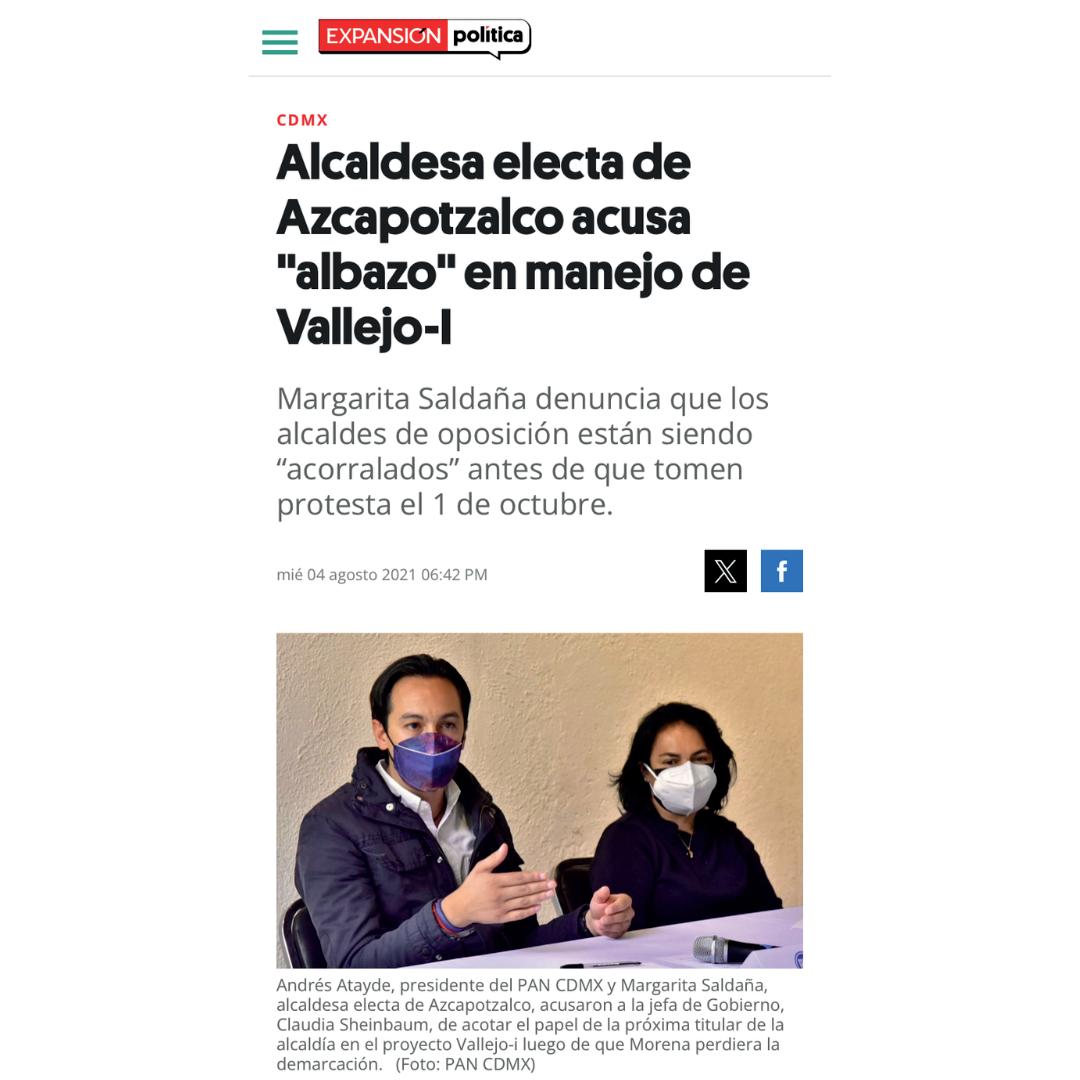
104 de 180 paices en índice de corrupción . (Transparencia Internacional, 2023)
3.2. ECONOMY
ECONOMÍA
PIB AZCAPOTZALCO
COMPARACIÓN ENTRE ALCALDÍAS Y EL VALLE DE MÉXICO

COMPARACIÓN DE LOS DIFERENTES PIBS EN LAS ALCALDÍAS DE LA CIUDAD DE MÉXICO Y EL VALLE DE MÉXICO

PIB POR ENTIDAD FEDERATIVA
En 2022, el PIB nacional a precios de mercado fue de 29 452 832 millones de pesos corrientes. Este monto se integró principalmente por la contribución de Ciudad de México, estado de México, Nuevo León, Jalisco, Guanajuato, Veracruz de Ignacio de la Llave, Coahuila de Zaragoza, Baja California, Chihuahua, Sonora y Puebla. En conjunto, contribuyeron con 66.5 por ciento.
Ciudad de México participó con 4.3 billones de pesos; estado de México, con 2.6 billones; Nuevo León, con 2.4 billones; Jalisco, con 2.2 billones; Guanajuato, con 1.4 billones; Veracruz de Ignacio de la Llave, con 1.2 billones; Coahuila de Zaragoza, con 1.1 billones; Baja California, con 1.1 billones; Chihuahua, con 1.1 billones; Sonora, con 1.0 billones y Puebla,con 1.0 billones.

International exports 2020
TOTAL INTERNATIONAL EXPORTS (AZCAPOTZALCO)
Azcapotzalco generated a $577 million dollar revenue by exporting its products to other countries. The main buyer being the United States consumed 48.2% of the products manufactured in Azcapotzalco. The CO2 emissions were below one million tonnes.
Azcapotzalco generó ingresos por $577 millones de dólares exportando sus productos a otros países. Las emisiones de CO2 fueron de menos de un millón de toneladas.
International exports 2021
TOTAL INTERNATIONAL EXPORTS (AZCAPOTZALCO)
Azcapotzalco generated a $720 million dollar revenue by exporting its products to other countries. The main buyer being the United States consumed 49.6% of the products manufactured in Azcapotzalco. Not only that, their CO2 emissions had a 24.78% increase compared to 2020.
Azcapotzalco generó ingresos por $720millones de dólares exportando sus productos a otros países. Además, sus emisiones de CO2 incrementaron un 24.78% respecto a 2020.
International exports 2022
TOTAL INTERNATIONAL EXPORTS (AZCAPOTZALCO)
1,423,230
Azcapotzalco generated a $842 million dollar revenue by exporting its products to other countries. The main buyer being the United States consumed 51.2% of the products manufactured in Azcapotzalco. Not only that, their CO2 emissions had a 45.92% increase compared to 2020.
Azcapotzalco generó ingresos por $842 millones de dólares exportando sus productos a otros países. Además, sus emisiones de CO2 incrementaron un 45.92% respecto a 2020.
Most exported products

There is a concerning trend in the rise of CO2 emissions, especially with the type of products that are mainly manufactured in the area. This highlights the need for sustainable practices and efforts to mitigate the environmental consequences of Azcapotzalco’s industrial activities as it continues to expand its global market presence.
Existe una tendencia preocupante en el aumento de las emisiones de CO2. Esto resalta la necesidad de prácticas sustentables y esfuerzos para mitigar las consecuencias ambientales de las actividades industriales de Azcapotzalco.
Referencias: Gobierno de México (2024). Azcapotzalco. Recuperado de: https://www.economia.gob.mx/datamexico/es/profile/geo/ Copper Aliance (2023). Cobre. Recuperado de: https://copperalliance.org/wp-content/uploads/2023/03/ICA-GlobalDecarb-202303-Spanish-Final-SinglePgs.pdf
Economy in relation to energy


To what extent is Gross Domestic Product (GDP) by industry equivalent to CO2 emissions?
Mexico City (CDMX) represents 4.9% of the national GDP in secondary industries. The secondary industries of the Industrial Zone Vallejo (ZIV) represent 5.8% of the GDP of CDMX. The area of the Zona Industrial Vallejo (ZIV) comprises a land of 389 hectares, of which 19% is secondary activity industry, which generates 85% of the GDP of ZIV.
CDMX representa el 4.9% del pib nacional en industrias secundarias. Las industrias secundarias de la ZIV representan el 5.8% del PIB cdmx El área de la Zona Industrial Vallejo (ZIV) comprende un terreno de 389 hectáreas, de las cuales el 19% es industria de actividad secundaria la cual genera el 85% del PIB de la ZIV.
Economy in relation to energy


Map 1 shows the size of the property in relation to the type of industry, while map 2 displays CO2 emissions. It indicates that there is no direct correlation between the size of the property, its impact on GDP, and the emitted CO2.
En el mapa 1 se muestra el tamaño del predio con relación al tipo de industria, el mapa dos muestra las emisiones de Co2 lo que nos dice que no existe relación alguna entre el tamaño del predio el impacto en el PIB y el Co2 emitido.
Economy in relation to energy
If energy were to be removed...
On the other hand, the next diagram illustrates the employees per industry in relation to the industrial sector. The total C02 emitted by personnel transportation, considering that they mainly travel by bus, subway, and private car, plus Co2 emitted by industry, amounts to 2,732,300kg Co2 aproximately per day. If energy were to be removed in Industrial Vallejo, CO2 emissions would decrease by (9%).
However, the blackout would result in 141,846 unemployed individuals. Considering that the average family size in Mexico is of 3.4 individuals, over 482,277 would be financial adversely affected. Additionally, 5.8% of the state GDP would decrease significantly. Furthermore, Mexico would lose a total of 842 million pesos in export revenue.
Diagrama: muestra los empleados por industria con relacion al sector industrial. El Co2 total emitido por el transporte del personal y la industria da un aproximado de 2,732,300kg Co2 al año. Si la energía se fuera en industrial vallejo las emisiones de Co2 reducirían un 9% Sin embargo esto resulta en 141,846 desempleados y un total de 482,277 personas afectadas. Por otro lado el 5.8% del PIB estatal desaparecería y México perdería un total de 842millones de pesos en materia de exportación.
LOSS OF 842MXN MILLIONS IN EXPORTS
ECONOMY CONCLUSIONS
Conclusiones
E C O N O M Y
CDMX SCALE
Azcapotzalco, the highest GDP among the other municipalities
$5.88 BDD (7.9% of SPGG GDP)
Territorial extension 33.66 km2
VALLEY OF MEXICO SCALE
Azcapotzalco is the 2nd highest gdp in the valley of Mexico below Cuautitlan Izcalli with $6.1 bdd (8.1% of SPGG gdp) Territorial extension 109 km2
NATIONAL SCALE
Comparison with SPGG Municipality, NL (municipality with the highest GDP in Mexico) has a GDP of 73.8 BDD and Its territorial extension is 47.46 km2
The northern section of Mexico generates the highest GDP than the central and southern areas.
G D P
E C O N O M Y
E N E R G Y
Fossil fuel energy disappears =
150,000 unemployed people
500,000 affected people
0% input to the GDP
“Standstill corporations”
9% CO2 emissions of CDMX = Poor air quality = Poor quality of life (Days under environmental contingency)
Bigger industry ≠ + CO2 emissions
QUALIT OF LIFE (LOCAL ECONOMIC SPILLOVER
The quality of life of the people that makes the “good” GDP possible is not equitable with the salary they currently have.
)
The salary of an average Vallejo worker is 10,000 to 20,000 pesos per month, having a GDP that exceeds 1 billion pesos.
Average family income in Mexico $13,239 pesos per month, considering that the basic basket (1830 weekly, 7320 monthly) represents more than 50% of the average monthly Mexican family income; excluding rent, utilities, transportation, extra expenses, etc.
COMPARISON OF SCALES AND OTHER COUNTRIES
Manhattan 59.1 km2 (as territorial reference)
Azcapotzalco CDMX 33.66 km2 (Manhattan 0.57 times) GDP=5.88 bdd
Liechtenstein PRINCIPALITY (NEIGHBORS: SWITZERLAND AND AUSTRIA) 160 km2 (Manhattan 2.7 times) GDP = 7.71 bdd
Burundi COUNTRY IN AFRICA (NEIGHBORS: DEMOCRATIC REPUBLIC OF THE CONGO)
27,834 km2 (Manhattans 471 times) GDP= 3.34 bdd The territorial extension does not impact the GDP of a country or state or municipality.
E X P O R T S
CO2 EMISSIONS
25 % Increase of emissions each year with the current trend
More revenue = more CO2
More revenue ≠ BETTER QUALITY OF LIFE
INDUSTRUY TRANSITION
¿Should pruducts be changed? ¿Can CO2 be a resource?
CO2 EMISSION IN 2022 in azcapotzalco, represent 60 % of an olympic pools capacity. In other words 1.5 million tons of CO2 were oozed in 2022. densidad del agua 1 kg/m3, densidad del co2 1.9 kg/m3 ‘
ECONOMY OPORTUNITIES
Oportunidades
Citizens or workers are not considered in making decisions to improve their quality of life
No se considera a los ciudadanos o trabajadores en la toma de decisiones para mejorar su calidad de vida
¿ ?
Workers choose to use cars because of car-oriented infrastructure, spending more of their salary on transportation
Los trabajadores optan por usar automóviles por la infraestructura orientada al coche, gastando más de su salario en transporte.
Workers are forced to use private modes of transport that result in more CO2 emissions
Los trabajadores se ven obligados a usar modos de transporte privados que provocan más emisiones de CO2
Hay planes para reducir las emisiones, pero no se han puesto en práctica.
La energia es privada, solo se beneficia el gobierno.
There are plans to reduce emissions, but they have not been put into practice. Energy is private, only the government benefits for it.
Transportation roads are inclined mainly for the distribution of goods (semi trucks)
Las vías de transporte están inclinadas principalmente para la distribucion de bienes (trailers)
Emissions from industries and transportation that move goods worsen air quality, therefore worsening the quality of life
Las emisiones de las industrias y los transportes que movilizan los bienes empeoran la calidad del aire, por ende empeorando la calidad de vida
Despite large GDP, workers are poorly paid and there is little investment in renewable energy
A pesar del gran PIB, los trabajadores están mal pagados y poca inversión en energías renovables
¿ ?
La mayoría de la población vive en pobreza moderada
The majority of the population lives in moderate poverty
Bad salaries for workers Malos salarios para los trabajadores
There is little sustainable infrastructure, causing CO2 emissions to be higher
Hay poca infraestructura sostenible, provocando que las emisiones de CO2 sean mayores
¿ ?
Men have lower life expectancy because they work in the industrial sector
Los hombres tienen menor esperanza de vida por trabajar en el sector industrial
CO2 is wasted instead of being used as a resource
El CO2 es desperdiciado en vez de usarse como recurso
3.3. URBAN
URBAN INFRAESTRUCTURE


Azcapotzalco built blocks
Study polygon
Traffic signs
estaciones
Estación de autobus
Parada de autobus
0 500 1000 m
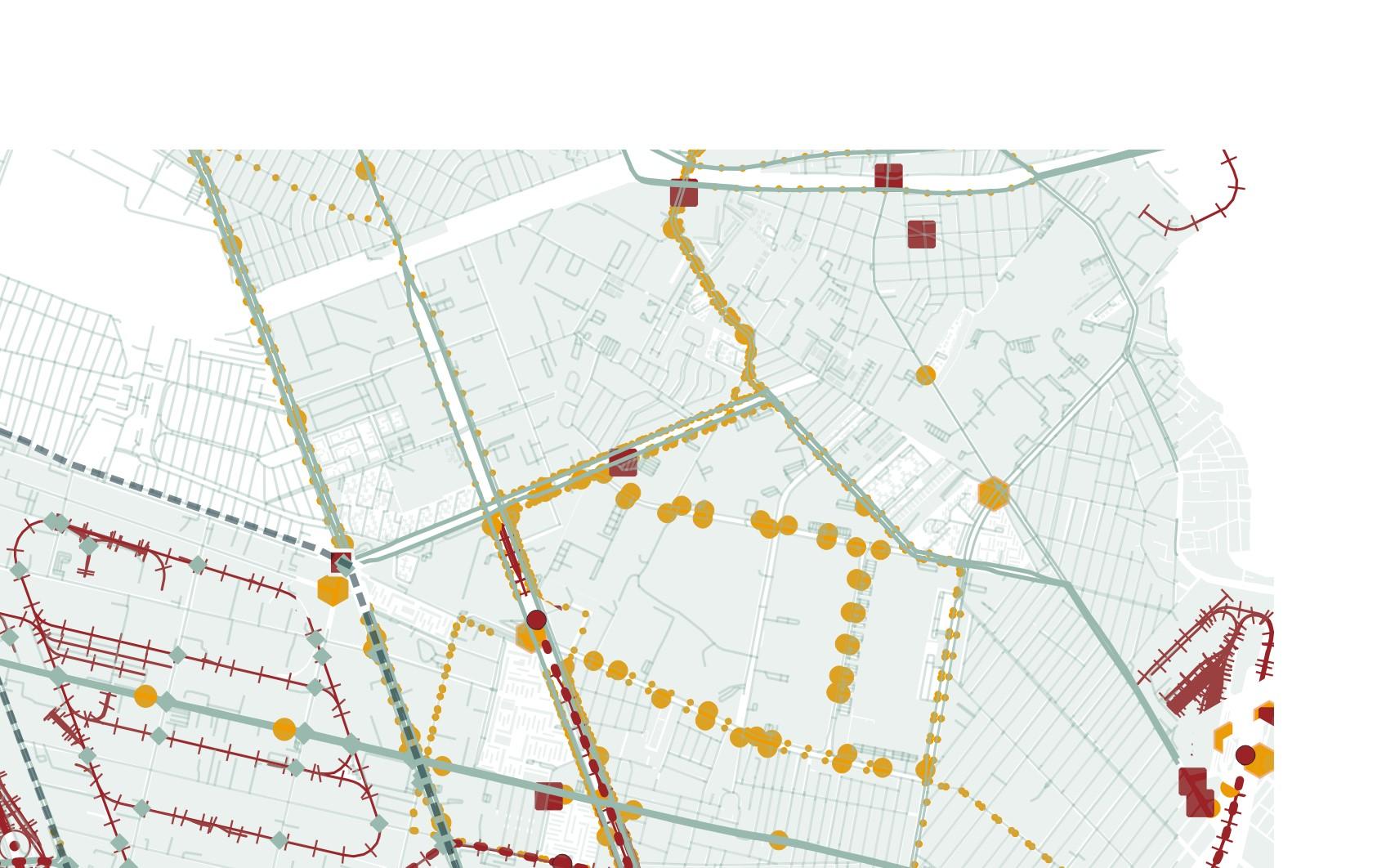
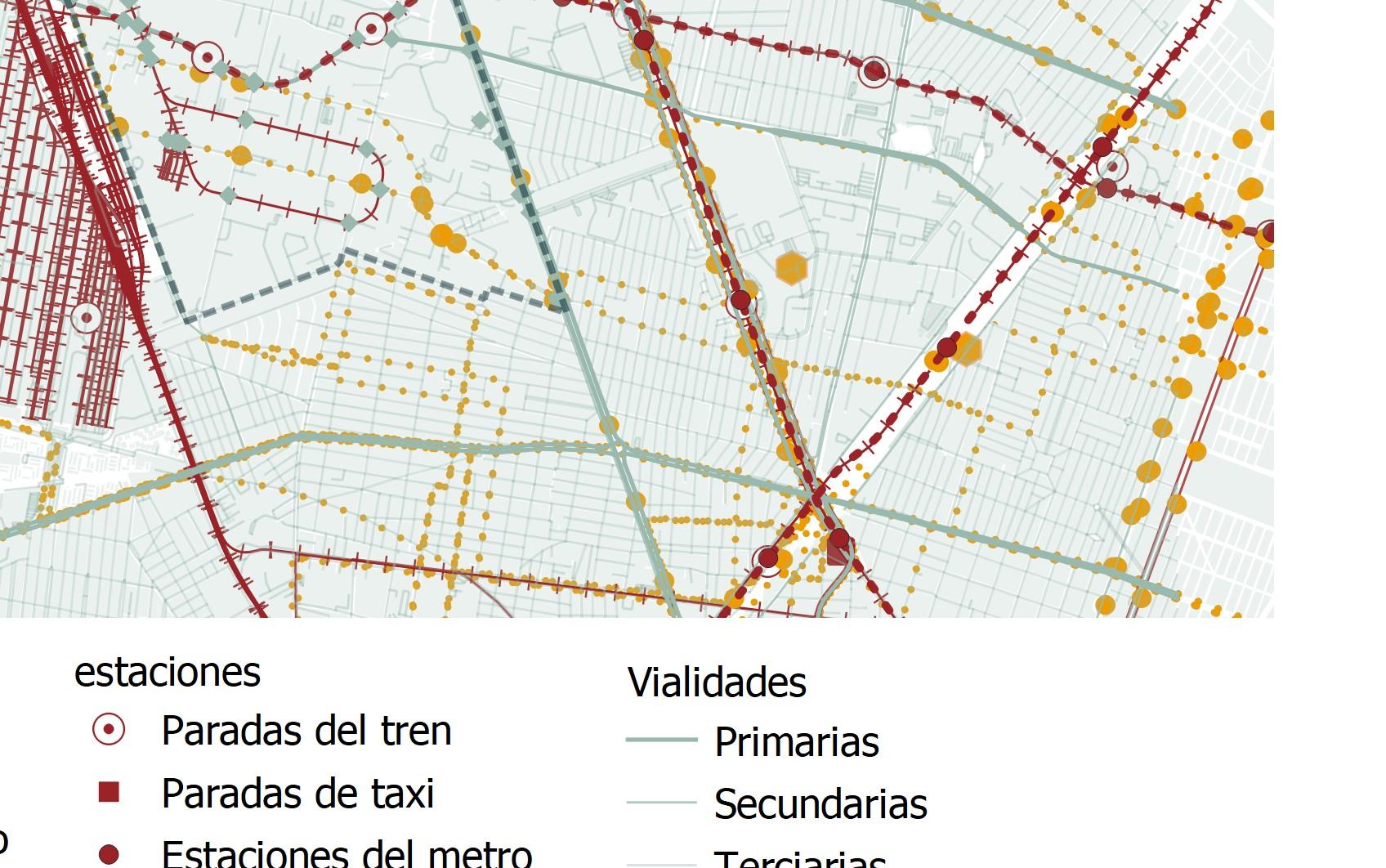
Estaciones del metro
Líneas del metro
Vías del tren
Rutas de autobus
Terciarias
Azcapotzalco mobility
The Azcapotzalco delegation has various ways in which people can move from one place to another every day. We decided to divide the different means of transportation that exist by color: All bus stations (diamonds), bus stops (circles) and routes (dotted lines) are marked in orange. It can be seen that on the east side of the map, there is a greater accumulation of bus stops, while the west of Azcapotzalco has really few.
Subsequently, the train stops are indicated with a double red circle, there are 13 of these and all the tracks are represented in this color. A large accumulation of tracks is observed on the west side of the city, this is a factor to consider because generally whenever there are train tracks, a social division occurs and this gives rise to insecurity. Continuing with the means of transport, the metro stations are marked with a simple red circle, there are 16 of these distributed and their passage is marked by a dotted line of the same color, it can be seen that it does not pass through the entire delegation and that it is divided from the middle of Vallejo down.
Finally, we have taxi stops that are marked with red boxes; these are only located in the northeast and southeast sectors of the city.
The roads are divided into primary (darker tone), secondary (everything in the middle) and tertiary (lighter tone). Almost all of the aforementioned means of transportation only pass through primary and secondary roads.
La delegación de azcapotzalco cuenta con diversas maneras en las que las personas se pueden trasladar de un lugar a otro todos los días.
Decidimos dividir los diferentes medios de transporte que existen por color:
En naranja se encuentran señaladas todas las estaciones de autobús (rombos), paradas de autobús (círculos) y rutas (líneas punteadas). Se puede observar que del lado este del mapa, hay una mayor acumulación de paradas de autobús, mientras que el oeste de Azcapotzalco tiene realmente pocas.
Posteriormente, las paradas del tren están indicadas con un doble círculo rojo, hay 13 de estas y todas las vías están representadas de este color. Se observa una gran acumulación de vías en el lado oeste de la ciudad, este es un factor a considerar debido a que generalmente siempre que existen vías del tren, se presenta una división social y esto da pie a la inseguridad. Continuando con los medios de transporte, las estacuones de metro están marcadas con un círculo simple rojo, hay 16 de estas distribuidas y su paso está marcado por una línea punteada del mismo color, se puede observar que no pasa por toda la delegación y que está dividida de la mitad de Vallejo hacia abajo. Por último, tenemos paradas fe taxi que están marcadas con cuadros rojos, estas solo se ubican en los sectores noreste y sureste de la ciudad.
Las vialidades se dividen en primaria (tono más oscuro), secundaria (todo de en medio) y terciaria (tono más claro). Casi todos los medios de transporte antes mencionados, pasan únicamente por las vialidades primaria y secundaria.
Mobility in Vallejo


Azcapotzalco built blocks
Study polygon
Traffic signs
estaciones
Estación de autobus
Parada de autobus
0 500 1000 m
Estaciones del metro
Líneas del metro
Vías del tren
Rutas de autobus


Terciarias
The Vallejo Industrial Zone has various means of transportation that reach it directly. As in the previous map, we decided to divide the different means of transportation that exist by color: All bus stations (diamonds), bus stops (circles) and routes (dotted lines) are marked in orange. There are 11 bus stops within Vallejo and 13 that are located exactly on the edge.
Subsequently, the train stops are indicated with a double red circle, there are 2 that enter Vallejo and 2 that are relatively close. All routes are represented in this color. Because the tracks enter the industrial complex, a clear division of zones is observed, which can be a bit dangerous for the physical integrity of people, either due to insecurity derived from the division itself, or due to some incident caused by the train.
Continuing with the means of transport, the metro stations are marked with a simple red circle, their passage is marked by a dotted line of the same color. No station is located within the complex, however, the main metro line passes right in the middle of Vallejo.
Finally, we have taxi stops that are marked with red boxes, there is only one near the industrial complex. The roads are divided into primary (darker tone), secondary (everything in the middle) and tertiary (lighter tone). Almost all of the aforementioned means of transportation only pass through primary and secondary roads. It is known that there are means of transportation that allow people to reach this destination, however, when we did the research we realized that there are no bicycle lanes and due to the train tracks that are abundant, pedestrian safety is uncertain.
La Zona industrial Vallejo cuenta con con diversos medios de transporte que llegan directamente a esta. Igual que en el mapa anterior, decidimos dividir los diferentes medios de transporte que existen por color: En naranja se encuentran señaladas todas las estaciones de autobús (rombos), paradas de autobús (círculos) y rutas (líneas punteadas). Hay 11 paradas de autobús dentro de Vallejo y 13 que se encuentran exactamente en el borde.
Posteriormente, las paradas del tren están indicadas con un doble círculo rojo, hay 2 que entran a Vallejo y 2 que están relativamente cerca. Todas las vías están representadas de este color. Debido a que las vías entran al complejo industrial, se observa una clara división de zonas, lo cual puede resultar un poco peligroso para la integridad física de las personas, ya sea por inseguridad derivada de la misma división, o por algún incidente causado por el tren.
Continuando con los medios de transporte, las estaciones de metro están marcadas con un círculo simple rojo, su paso está marcado por una línea punteada del mismo color. Ninguna estación se encuentra ubicada dentro del complejo, sin embargo, la vía principal de metro pasa justo en medio de vallejo. Por último, tenemos paradas de taxi que están marcadas con cuadros rojos, solo existe una cerca del comolejo industrial.
Las vialidades se dividen en primaria (tono más oscuro), secundaria (todo de en medio) y terciaria (tono más claro). Casi todos los medios de transporte antes mencionados, pasan únicamente por las vialidades primaria y secundaria.
Es notorio que hay medios de transporte que permiten que las personas lleguen a este destino, sin embargo, cuando hicimos la investigación nos dimos cuenta de que no hay ciclovías y debido a las vías del tren que son abundantes, la seguridad del peatón es incierta.
Land use map


Equipment
Housing
Housing with commerce Industry

 Industria
0 500 1000 m
Study polygon
Azcapotzalco built blocks
Land use industrial area Vallejo
Industria
0 500 1000 m
Study polygon
Azcapotzalco built blocks
Land use industrial area Vallejo
The map shows the 3 types of soils existing in the Vallejo industrial zone:
The predominant type of use is industrial, indicated in the strongest tone of color. This makes sense because, as its name indicates, the 685 hectares of the Vallejo Industrial Zone house 1,580 economic units.
Subsequently, you can see the use of residential land with commerce in the middle tone, it is really very little compared to the aforementioned.
Finally, there is the use of residential land, indicated in the lightest tone. Analyzing this last point and comparing information with the housing map, we realized that there is more infrastructure of this type than is allowed due to the land use used.
En el mapa se observan los 3 tipos de suelos existentes en la zona industrial Vallejo:
El tipo de uso predominante es el industrial, indicado en el tono más fuerte de color. Esto tiene sentido debido a que como su nombre lo indica, las 685 hectáreas de la Zona Industrial Vallejo albergan mil 580 unidades económicas. Posteriormente, se puede observar el uso de suelo habitacional con comercio en el tono de en medio, realmente es muy poco comparado con el antes mencionado.
Por último existe el uso de suelo habitacional, indicado en el tono más claro. Analizando este último punto y comparando información con el mapa de vivienda, nos dimos que hay más infraestructura de este tipo de la que está permitida debido al uso de suelo utilizado..




Map showing the industries from 2010 and 2020 and possibles industry clusters in Vallejo.
Aglomeración industrial







Industrial growth in Vallejo

Vallejo, according to the Images 1 and 2, has been an industrial node from more than 90 years, giving space to big companies to grow and converge with each other.Also, giving chance to clusters to emerge and help to create more value chains in the industry sector of Vallejo.
Vallejo, según las Imágenes 1 y 2, ha sido un nodo industrial desde hace más de 90 años, dando espacio a grandes empresas para crecer y converger entre sí,. además dar oportunidad a que surjan clusters y ayuden a crear más cadenas de valor en el sector industrial de Vallejo.
Density population along the time





0 500 1000 m
The nolli map shows the constructions that exist in the study site, those that are located in Vallejo, are seen in black, and those that are located around, are part of Azcapotzalco and are indicated in gray. It can be seen that the area has a high density of buildings, which indicates that there is great human activity in the area. The space that is white represents all the construction voids that exist, it is really little compared to the color gray or black. This is a clear indicator that public space is needed, unbuilt areas that can be used as small green lungs of the place.
El mapa nolli muestra las construcciones que existen en el sitio de estudio, las que se encuentran en Vallejo, se observan en color negro, y las que están ubicadas alrededor, forman parte de Azcapotzalco y se encuentran indicadas en color gris. Se puede observar que la zona cuenta con una alta densidad de construcciones, lo cuál indica que hay una gran actividad humana en la zona. El espacio que se encuentra en blanco representa todos los vacíos de construcción que existen, es realmente poco comparado con el color gris o negro. Este es un claro indicador de que hace falta espacio público, áreas sin construir que puedan ser utilizadas como pequeños pulmones verdes de la zona.
URBANISM Urbanismo

